Great Britain, September 3rd, 1939. The morning is hazy, but the fog has cleared up relatively quickly. The sky is overcast and the temperature is uncommonly high at 20°ish degrees Celsius by 6am. In the East of England it will even reach the 30’s in the afternoon. The last remnants of the warmish spell that has persisted from before the start of the century will end with the very cold (and bitter) winter of 1939-40.
It's a Sunday but not an usual one. Germany has invaded Poland two days prior and many Englishmen and -women are listening to the BBC to know what will happen next. Their anxious wait is rewarded – although the term is utterly paradoxical for the outcome – at 11:15 am. Prime Minister Neville Chamberlain, after a brief introduction, announces: "This country is at war with Germany". Fade to black.
War. In 1939, the British Government found itself suddenly in need to equip an Army. This also meant that soldiers, pilots and sailors needed watches. Unfortunately, the great British horological tradition which had already supplied the British Military in the past with top tier products, especially marine chronometers for the Royal Navy (Harrison, Arnold) or Smith’s trench watches in WWI, had largely lost its momentum to the more powerful Swiss production capabilities. Besides, the english manufacturing capability was more needed in the weapons industry.
Switzerland would export very large quantities of watches and pocket watches equally to Allied forces and the Germans. The British military was initially supplied with so-called A.T.P. watches ordered in 1939. A.T.P. stands for ‘Army Trade Pattern,’ the set of design rules created for watches destined for Her Majesty’s armed forces. The ‘pattern’ was the following: a watch case from 30 to about 34mm. A white or silver dial with black numerals for legibility. A small second or ‘running seconds’ on the dial to aid in more precise timing coordination. Fixed bars at the lugs so the strap always stays connected to the wearer. A reliable and accurate movement of 15 jewels or more. Finally, the hands and dial markers needed to be painted with some sort of luminous material to aid in night work. Seventeen Swiss watch companies answered the call by the British Ministry of Defense to build these timepieces. They were: Buren, Cortebert, Cyma, Ebel, Enicar, Font, Grana, Lemania, Leonidas, Moeris, Reconvilier, Record, Revue, Rotary, Timor, and Unitas.
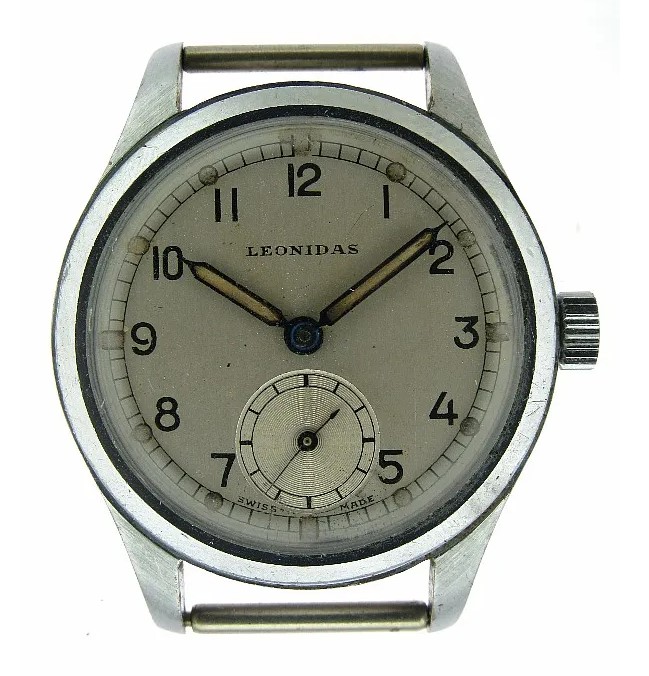
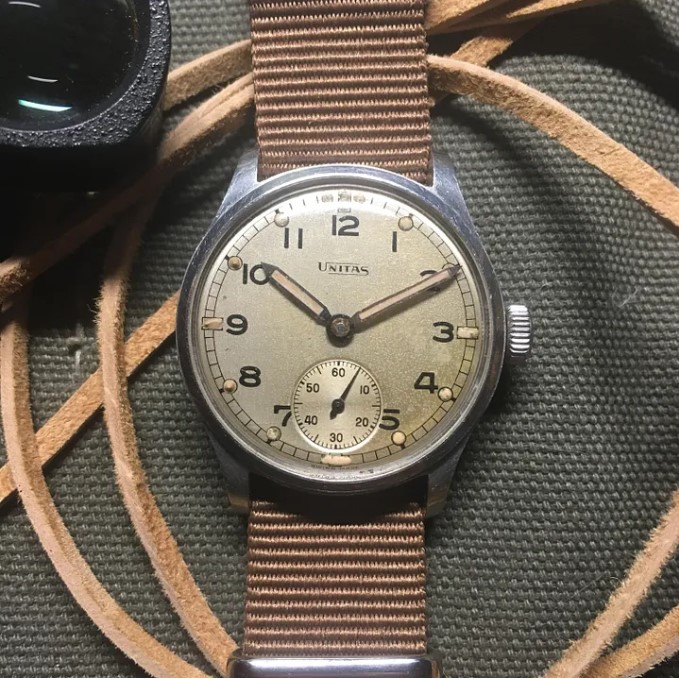
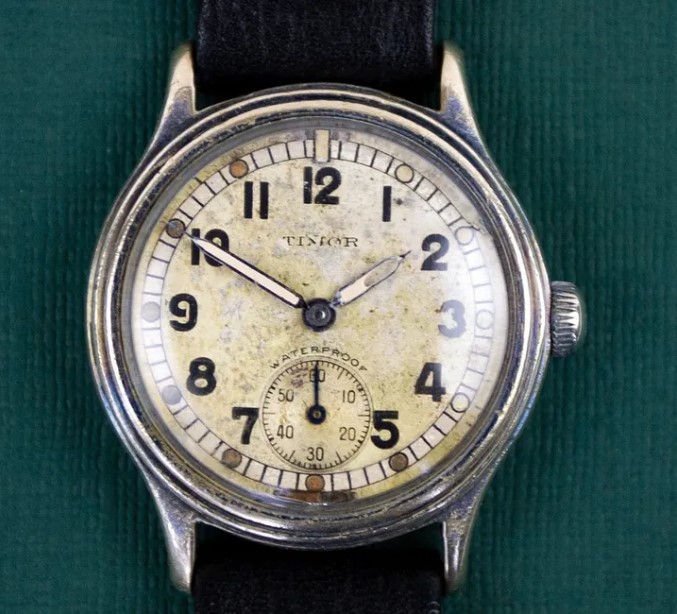
However, by 1944 the British Ministry of Defense thought these were not suitable to the needs of British soldiers, and decided to place an order for custom-built wristwatches. These needed to be accurate, reliable and durable, which in watchmaking terms meant they had to be regulated to chronometer standards, and also be waterproof and shockproof.
The watches also had to have a black dial, Arabic numerals, luminous hour and minute hands, luminous hour markers, a railroad minute track, a shatterproof crystal, and a stainless-steel case. Powering them would be 15-jewel movements, measuring between 11.75 and 13 lignes (cfr.: https://en.wikipedia.org/wiki/Ligne...es to,equivalent of 0.0888 international inch.).
Twelve companies would fulfill this brief: Buren, Cyma, Eterna, Grana, Jaeger-LeCoultre, Lemania, Longines, IWC, Omega, Record, Timor, and Vertex. A thirteenth brand, Enicar, was also addressed by the MoD but never supplied the watches.

Each manufacturer delivered according to its production capabilities, from the 25.000 of Omega to the 1.000 (maybe up to 5.000) of the Grana. The Dirty Dozen started production in February and March 1945 and supplied their watches later that year.
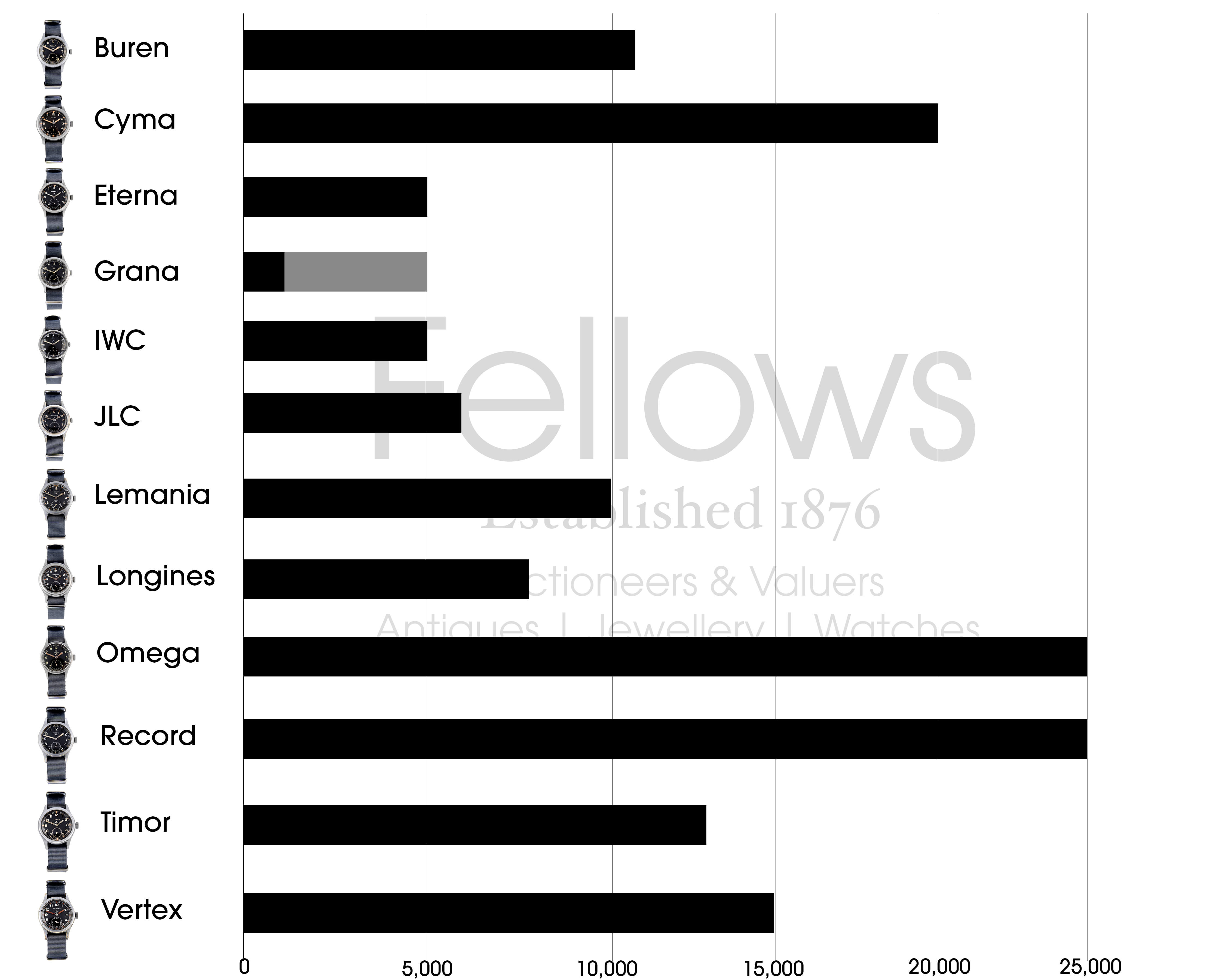
The Dirty Dozen are easily identifiable by the engraving on the back. The three Ws, which stand for for Watch, Wrist, Waterproof, and indicate the type of good in order to distinguish them from weaponry. Other defining features include Broad Arrow heads; the use of the Broad Arrow for government goods goes all the way back to Sir Philip Sidney, Joint Master of the Ordnance in 1585, whose family used the Broad Arrow in its coat of arms – traditionally used to denote the property of the UK government - , on the dial, inner case, and at the back, and two more lines of engravings at the back: a military serial number – a capital letter followed by up to five digits – above a second, standard civil serial number - some watches have the civil one on the inner case.
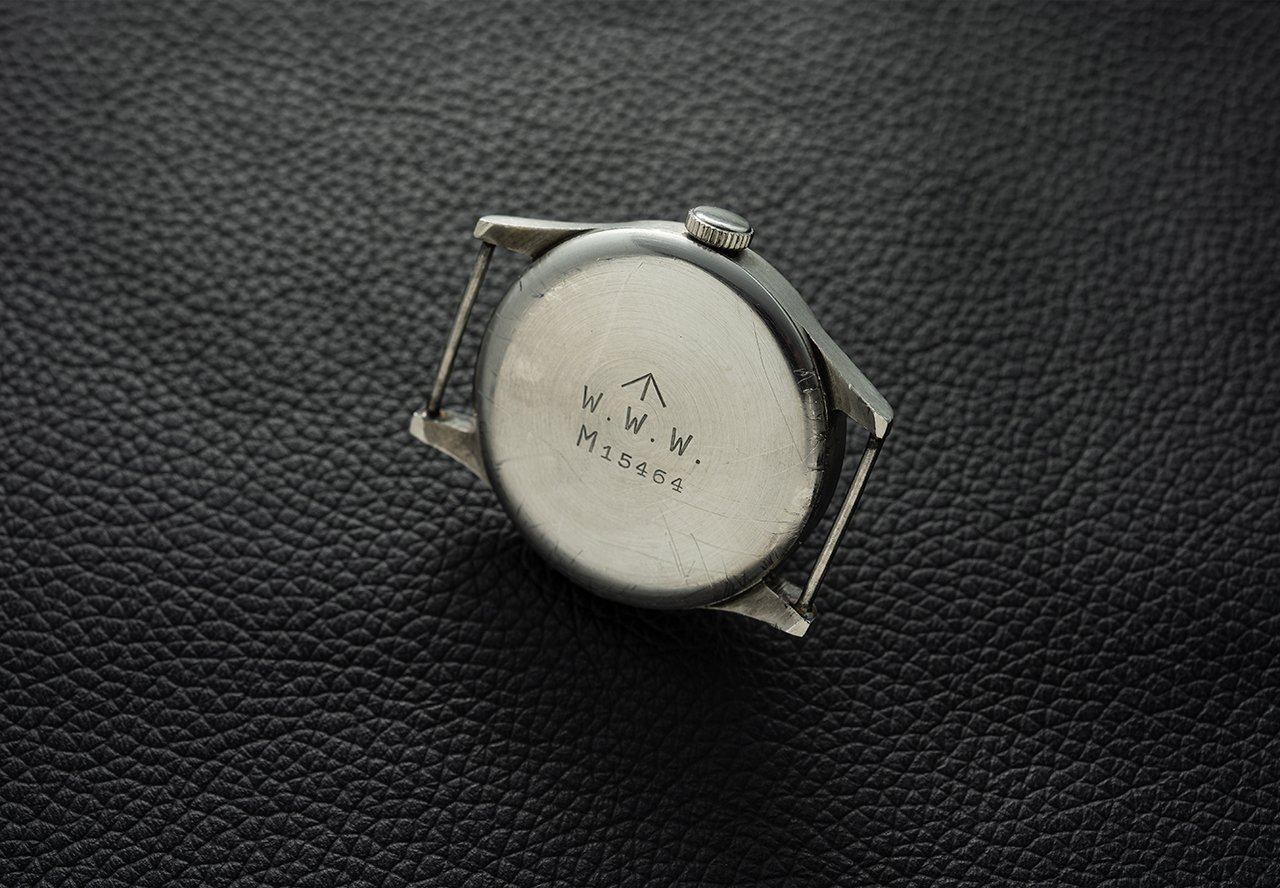
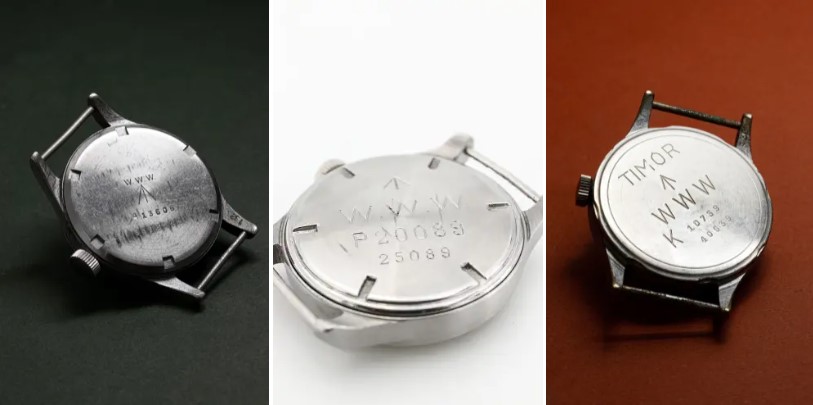
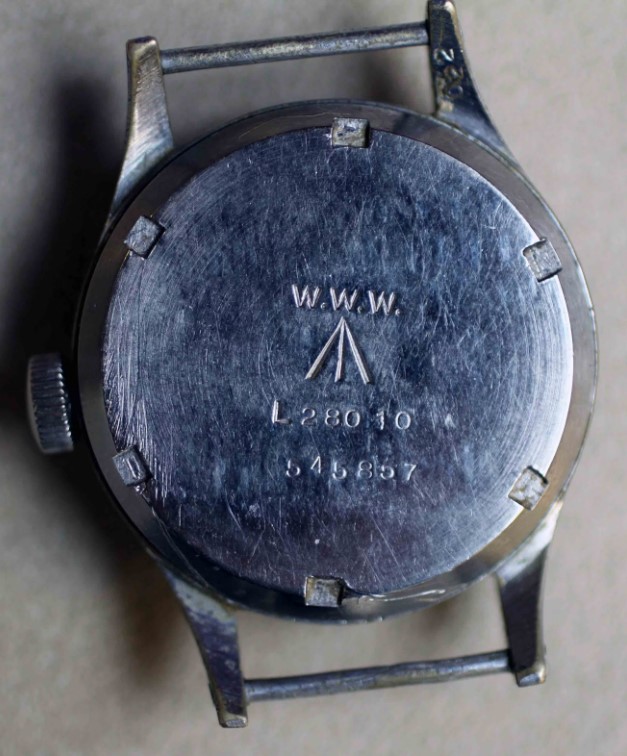
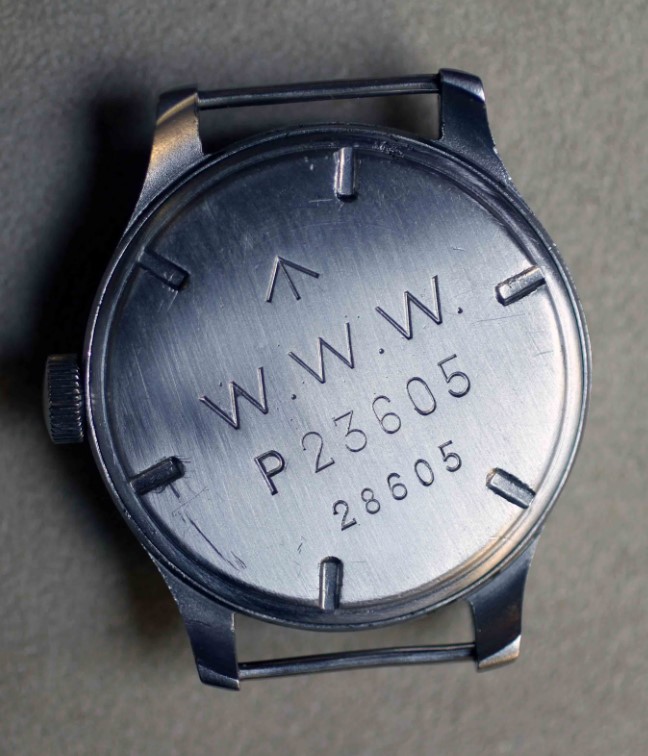

The specification from the MoD left room for interpretation in designing the watches. No two versions look alike. Sizes varied quite a bit. The Grana, IWC, JLC, Omega, and Vertex versions are the smallest, measuring 35mm. The Longines is the largest at 38mm.
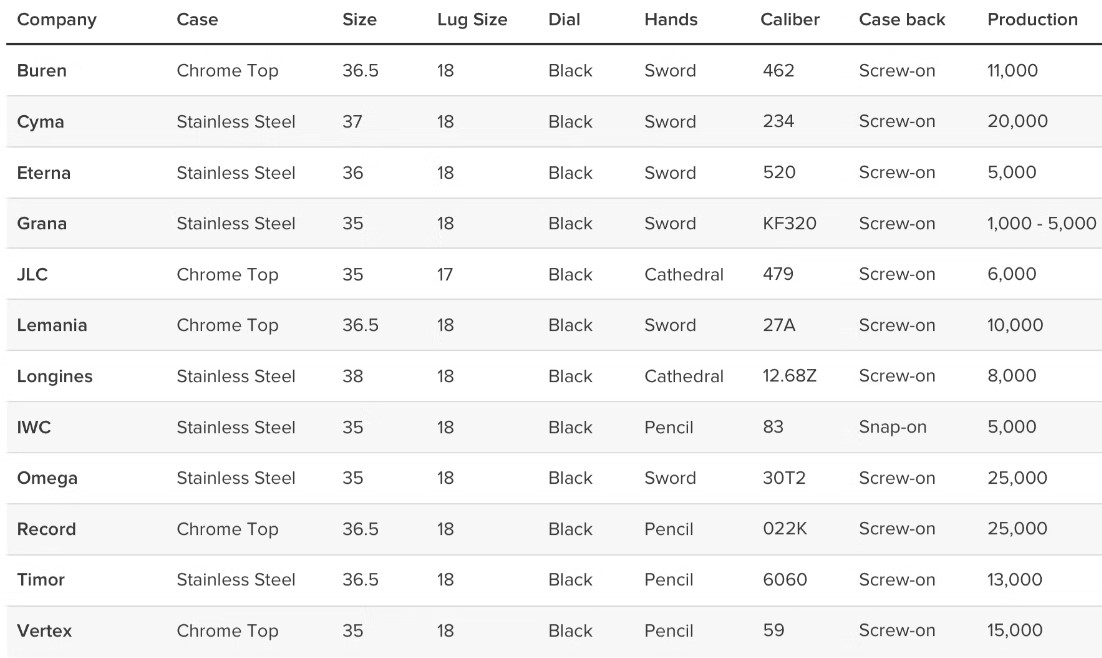
Another distinguishing feature is the handset. We see variations from the narrow syringe-style hands of the Vertex to the large cathedral handsets of the Longines and JLC. The dials are nowhere near the same, either. The numerals are different — just let your eye flow across all the 4s, for instance. The sub-dials for the running seconds are different sizes, and some feature numerals where others don’t. All feature the government-specified arrowhead, but even that is executed in different shapes.
The cases vary quite a bit as well. Some are stainless steel, whereas others are chrome-plated. To find a good, unrestored example of the latter nowadays is nearly impossible. The case shape itself is also different across the manufacturers. We see stepped bezels, domed bezels, flat bezels, and sloped bezels. Lastly, all were fitted with a screw-in case back except for the IWC, the back of which was snap-on.
Since the watches were only delivered in the second half of 1945, many did not see that much action. A total of around 150,000 watches were produced. They primarily landed with specialist units, such as radio operators. While many did not, large numbers also did end up on the battlefield.
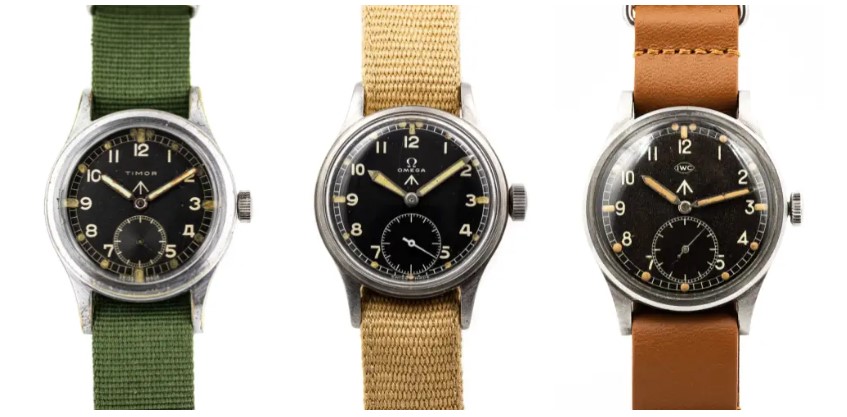
Due to the extreme conditions they were subjected to, many of them were repaired and restored at some point during their lifetime. And that meant being sent back to the Corps of Royal Electrical & Mechanical Engineers (R.E.M.E), which dealt with all mechanical equipment in need of maintenance or repair, including watches worn by military personnel.
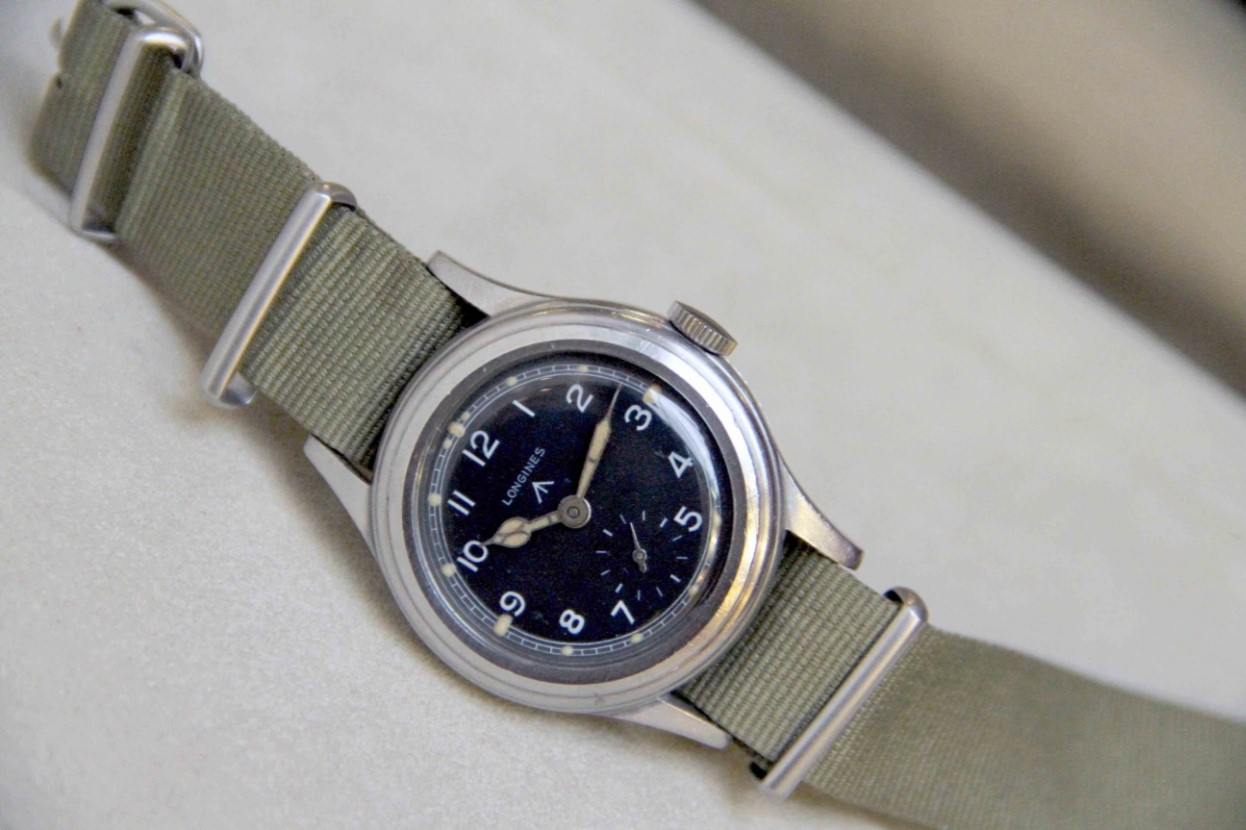
Of course, the Corps had little interest in preserving the originality of the watches that came back. Their primary concern was to get them back in the field as quickly as possible, and they found it much more practical and time efficient to restore watches using MoD replacement parts of lower quality and in some cases, with parts from other models. Mistakes were made, especially when changing case backs. And then there's what happened after the war. In the 1960s, dials containing radium and promethium were replaced by non-radioactive dials.
A small number of W.W.W.s was salvaged by the MoD after the war. Interestingly, these were then sold to other armed forces. Some went to the Dutch and Indonesian armies, others to the Pakistani military. Some of these watches saw action in Indonesia during the decolonization from the Netherlands. Most W.W.W.s feature two serial numbers on the case back, one military and one civilian. The resold versions received a third and sometimes a fourth serial number from their new owners. This makes Dirty Dozen watches with three/four serials extra collectible today besides the elusive Grana.
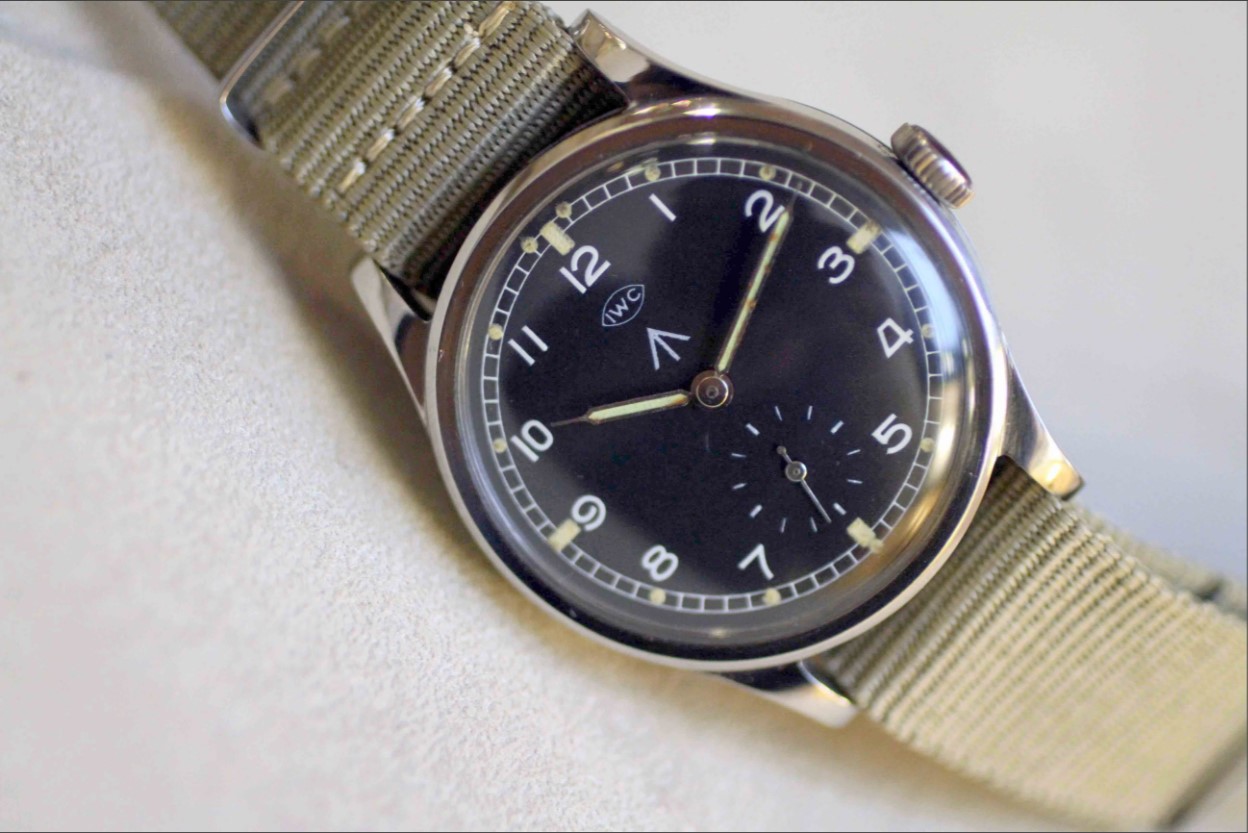
The moniker “Dirty Dozen” derives from the namesake movie from 1967 starring Lee Marvin, Charles Bronson, John Cassavetes, Telly Savalas, Donald Sutherland, Ernest Borgnine, George Kennedy and others. The movie, although heavily romanticizing World War II, is a must-see for the lovers of the genre. The younger audience will know Quentin Tarantino’s Inglorious Basterds, which directly references the old movie in more than one scene.
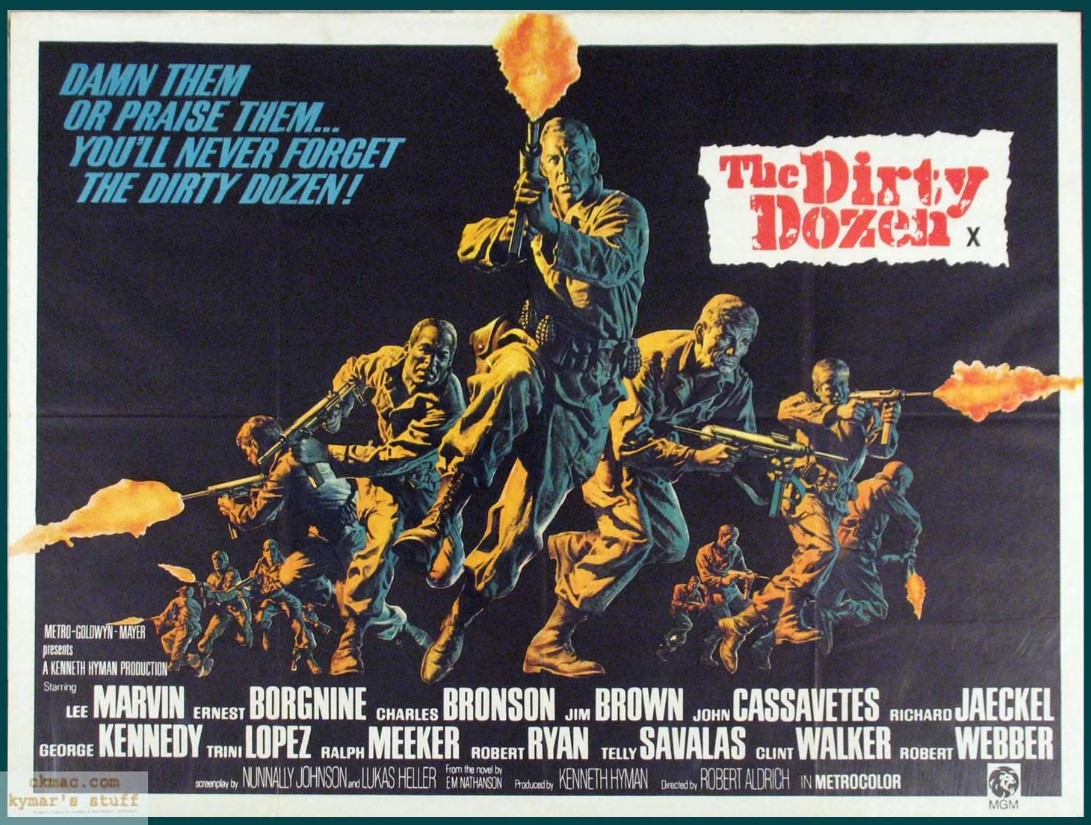
Analogous romanticism is today reserved to the Dirty Dozen watches. These are highly collectible and in some cases surprisingly affordable in comparison to what the watch world is used to today. But again, some of them are also quite rare. It is believed that there are no more than 20 full collections featuring all 12 watches. A full collection was sold in August 2020 for 27.000 GBP (>34,000 incl. fees).
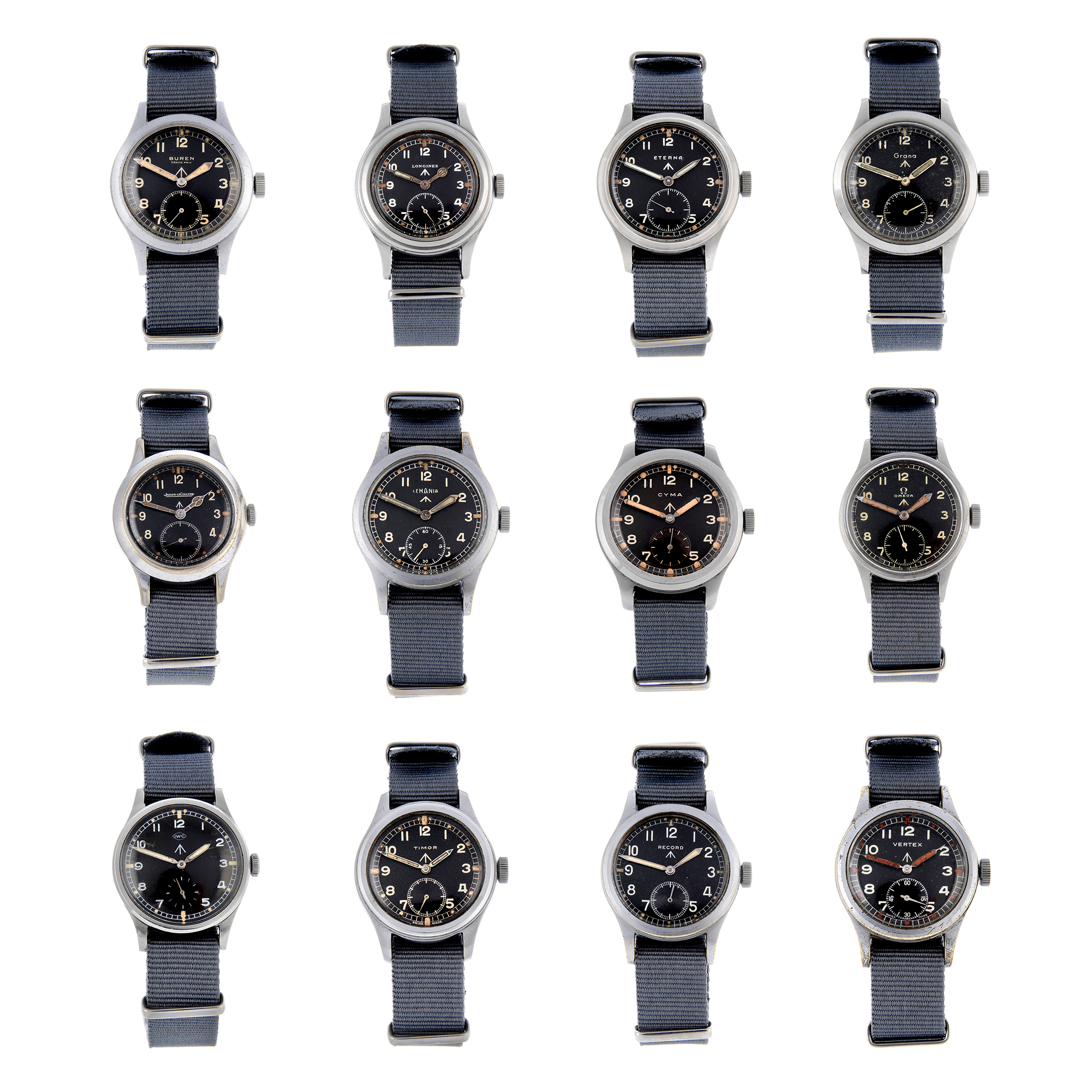
Buren
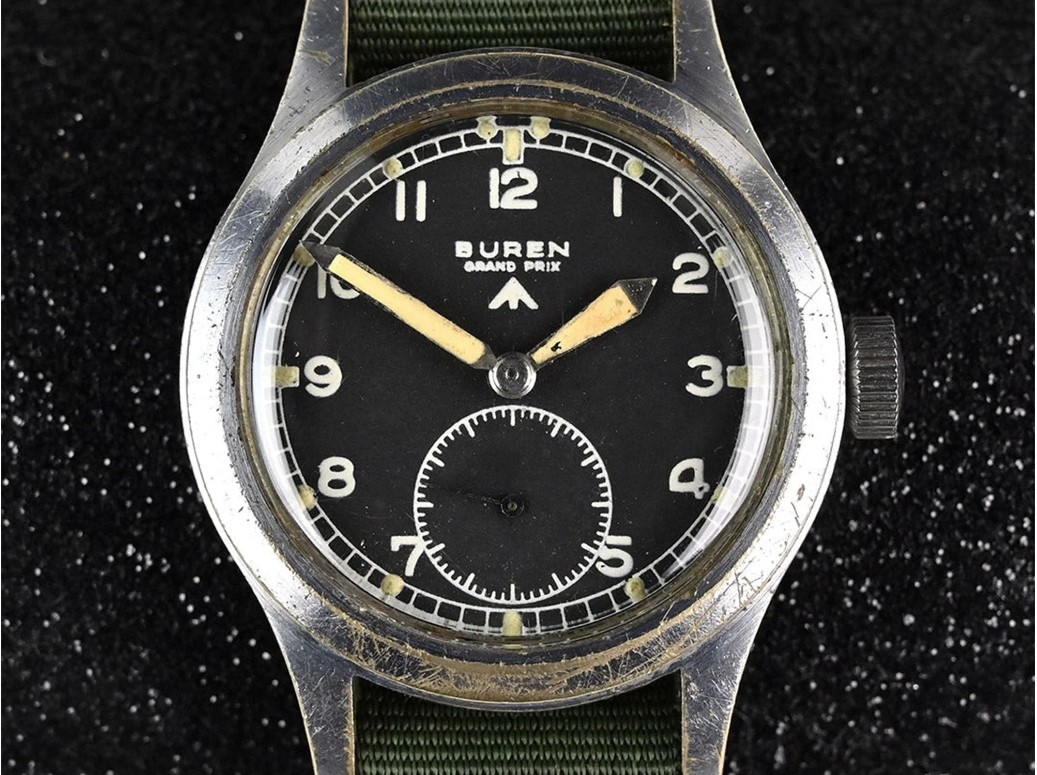
Buren Watch Company was founded in the Swiss canton of Bern in 1898, owned and operated by London-based H. Williamson Ltd. primarily as a maker of pocket watches and table clocks. In 1966, Swiss-based Buren became part of Hamilton Watch Co., which at the time was still based in the U.S.A., and quickly became the manufacturer of the majority of Hamilton watches, effectively accelerating the end of domestic production for the historical American brand. The merged Hamilton-Buren firm was one of a handful of pioneering Swiss watch manufacturers, along with Heuer and Breitling, that developed the groundbreaking Chrono-Matic caliber in 1969, one of the world’s first self-winding chronograph movements. In 1971 it became part of the SSIH group and eventually the Swatch Group. Hamburg-based Schweizer Uhren Edicionen acquired the Buren brand and operates it today. Buren’s chrome-finished watch measured 36.5mm, with sword hands, and carried the Caliber 462 “Grand Prix” movement, which the company made in-house.
Cyma
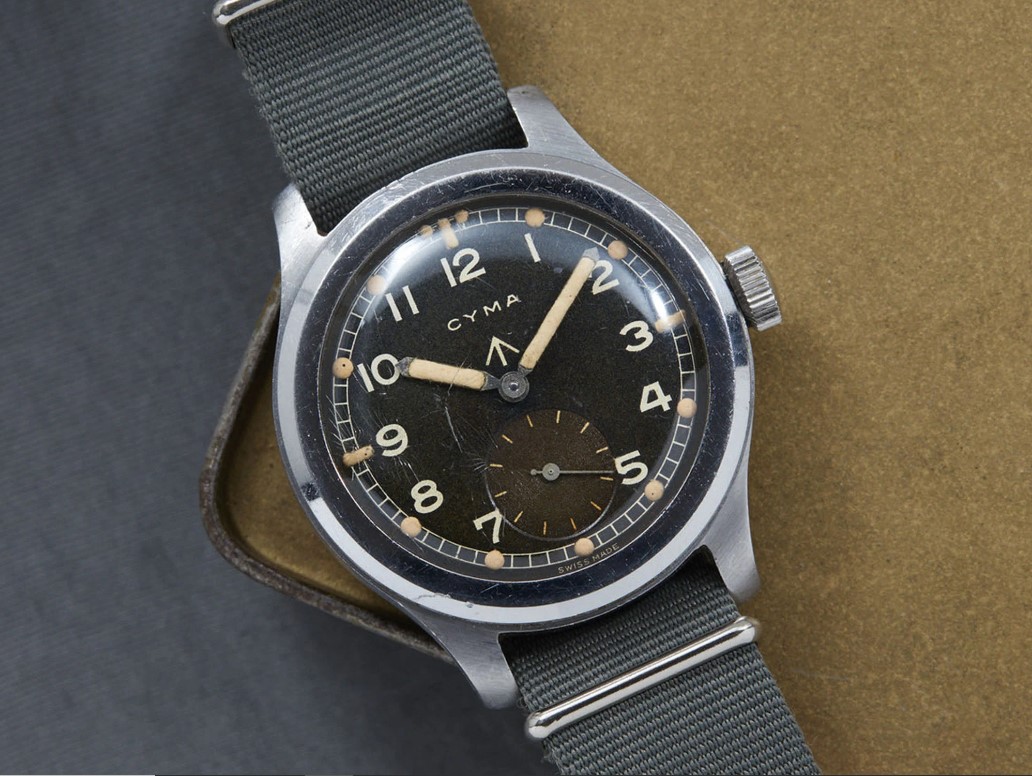
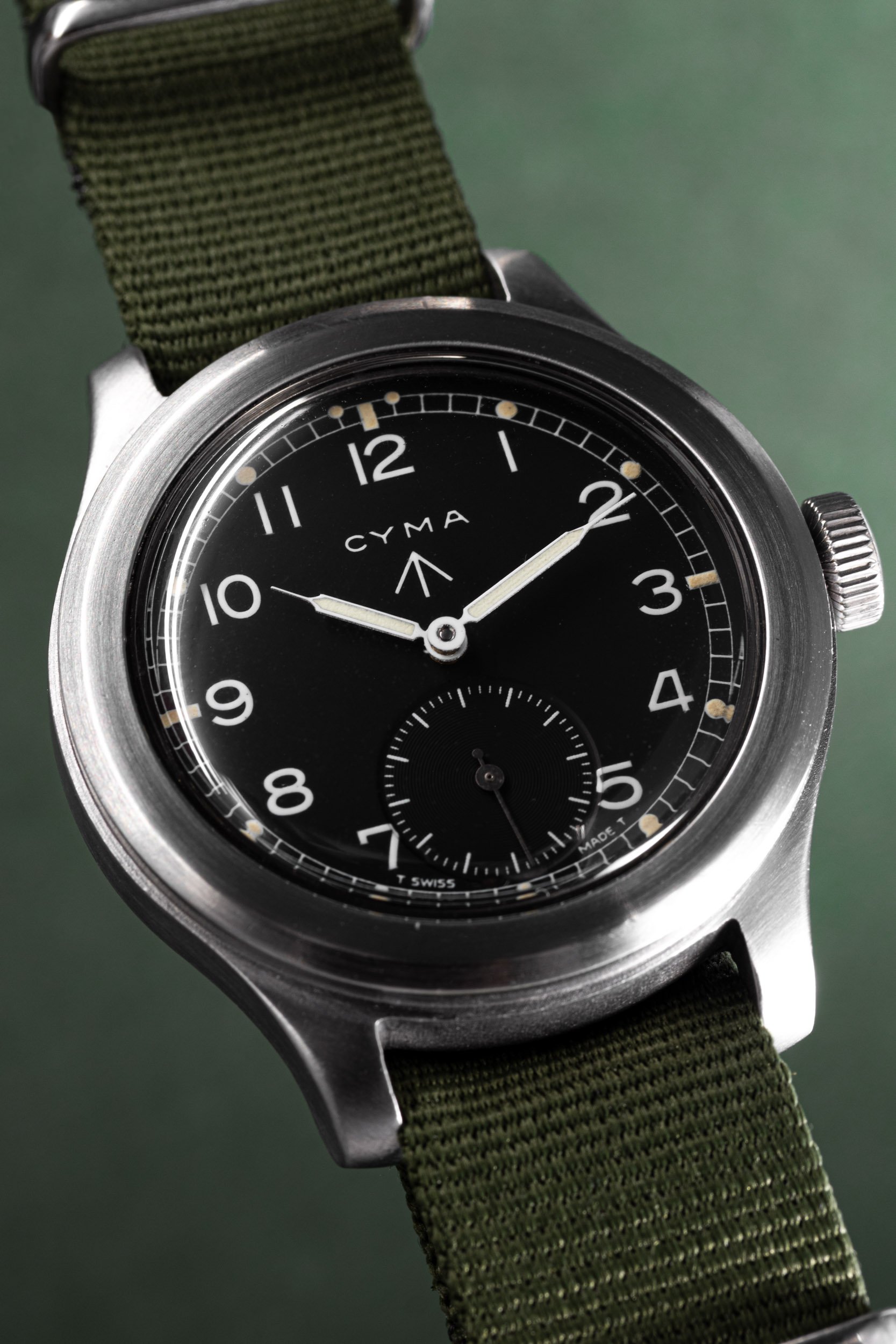
Brothers Joseph and Theodore Schwob founded Cyma in 1862, taking the name from the Latin word for “sprout,” which evolved into the French word for “summit” (cime). It made luxury watches touted for their resistance to electricity, magnetism, and temperature extremes at its factory in La Chaux-de-Fonds and became known for its expertise in high complications like minute repeaters. Today, still based in Switzerland, the company is owned by Hong Kong-based Stelux International Ltd. Despite its relatively healthy production run compared to others (20,000 pieces, according to estimates), Cyma’s Dirty Dozen Watch is a favorite of many due to the sizing of its case (a somewhat contemporary 37mm) and its construction in stainless steel, a quality material that was rare at the time due to wartime shortages. Inside is the mechanical Caliber 234, with 15 jewels.
Eterna
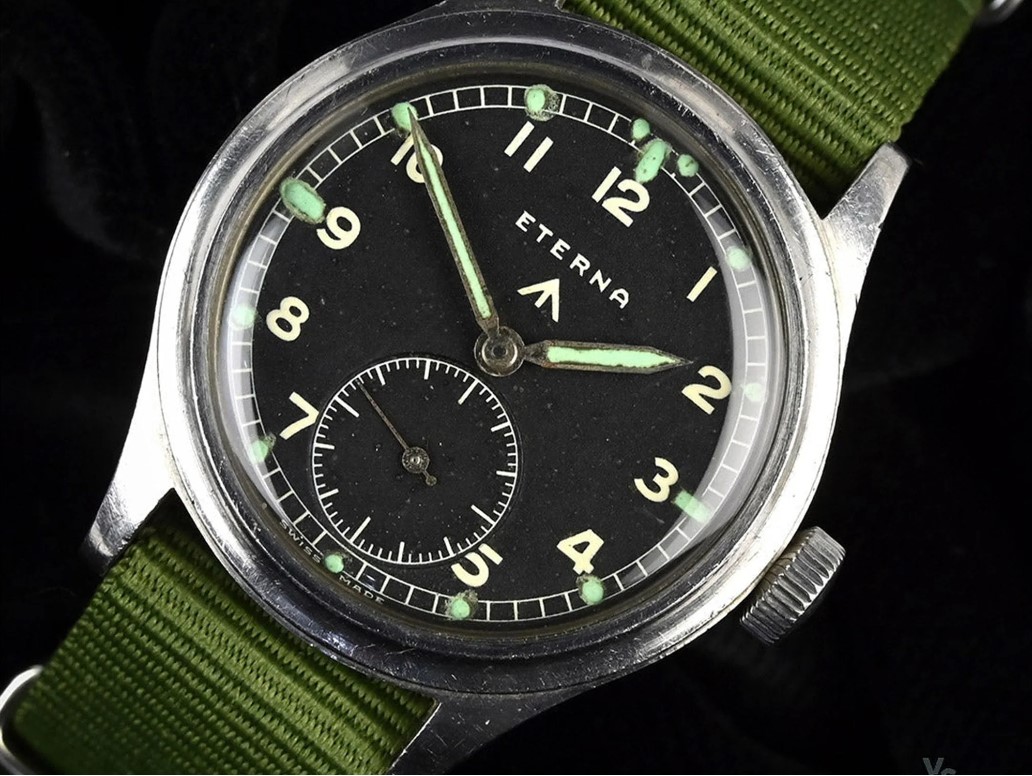
Founded in 1856, Grenchen-based Eterna can lay claim to many watchmaking milestones but is renowned mainly for providing the foundation of today’s ETA movement-manufacturing giant: the co-founding Schild family were the technical innovators who set up the subsidiary ETA SA in 1932, which is today part of the Swatch Group and a major pillar of the Swiss watch industry. Outside of that, Eterna is known for the release of the pioneering Kon-Tiki divers’ watch, inspired by explorer Thor Heyerdahl’s legendary Polynesian raft expedition in 1947; for the development of the Eterna-Matic movement in 1948, the first caliber with a friction-reducing ball-bearing rotor system; and for one of the first wristwatches with a mechanical alarm. Today, the venerable firm is owned and operated out of China by Citychamp Watch and Jewellery Group. Eterna’s Dirty Dozen watch (36mm in stainless steel, with the manually wound in-house Caliber 520) is among the rarest, with only 5,000 or so pieces ever made.
Grana
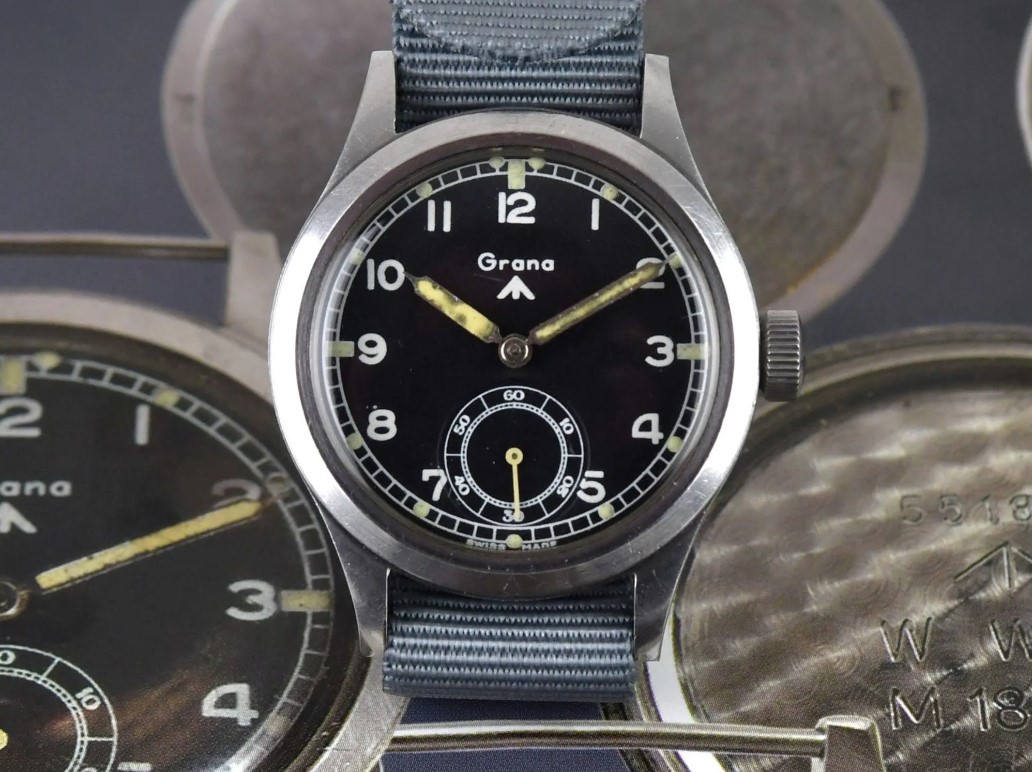
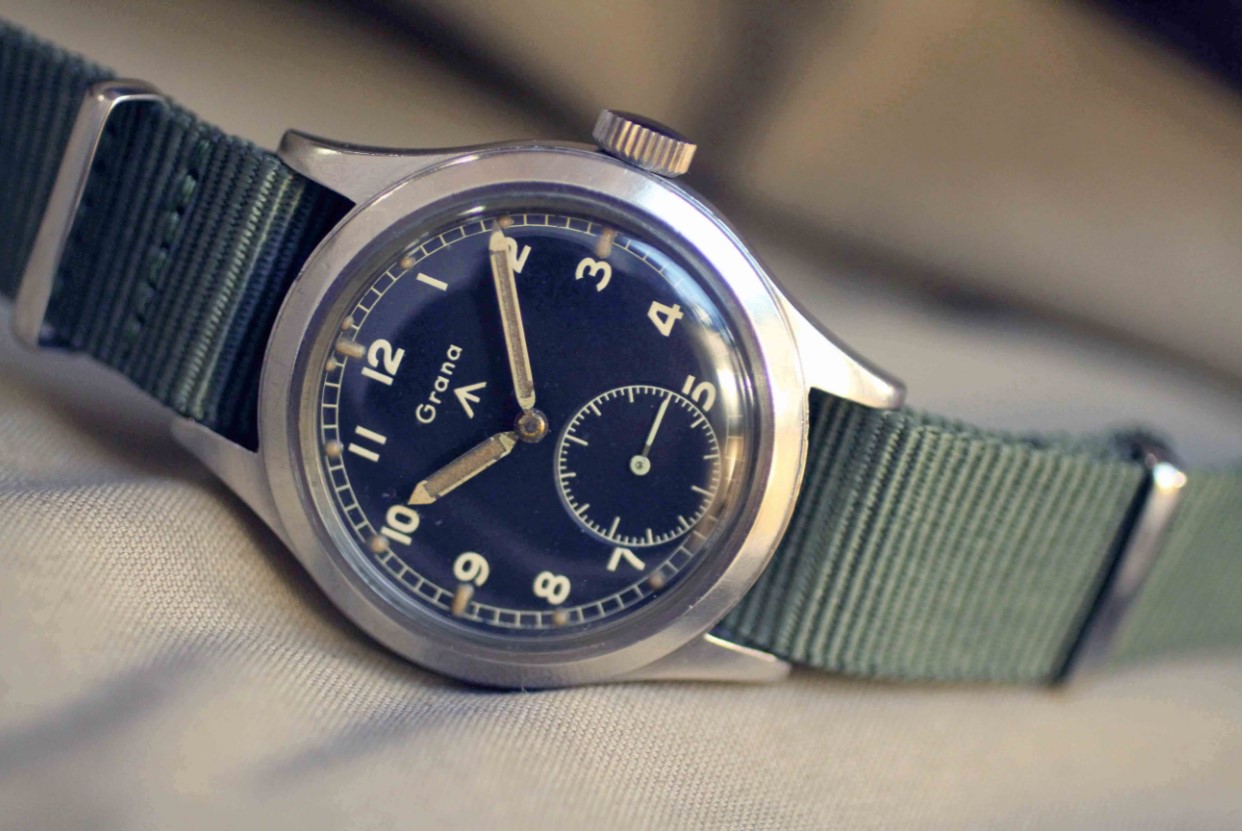
Grana is a name you won’t find on a watch dial these days, because in the 1940s this Grenchen-based watch manufacturer, founded in 1888 by the Swiss Kurth brothers Adolf and Alfred, became known as Certina. While far from the most famous brand name on this list, Grana has the distinction of making the rarest and thus most coveted timepiece in the Dirty Dozen, the Holy Grail of the Holy Grails. No one’s sure how many were produced, but the number is almost certainly fewer than 5,000 and maybe as few as around 1,000. In April 2022, a Grana watch from the Dirty Dozen sold at auction for 12,000 GBP.
Jaeger-LeCoultre
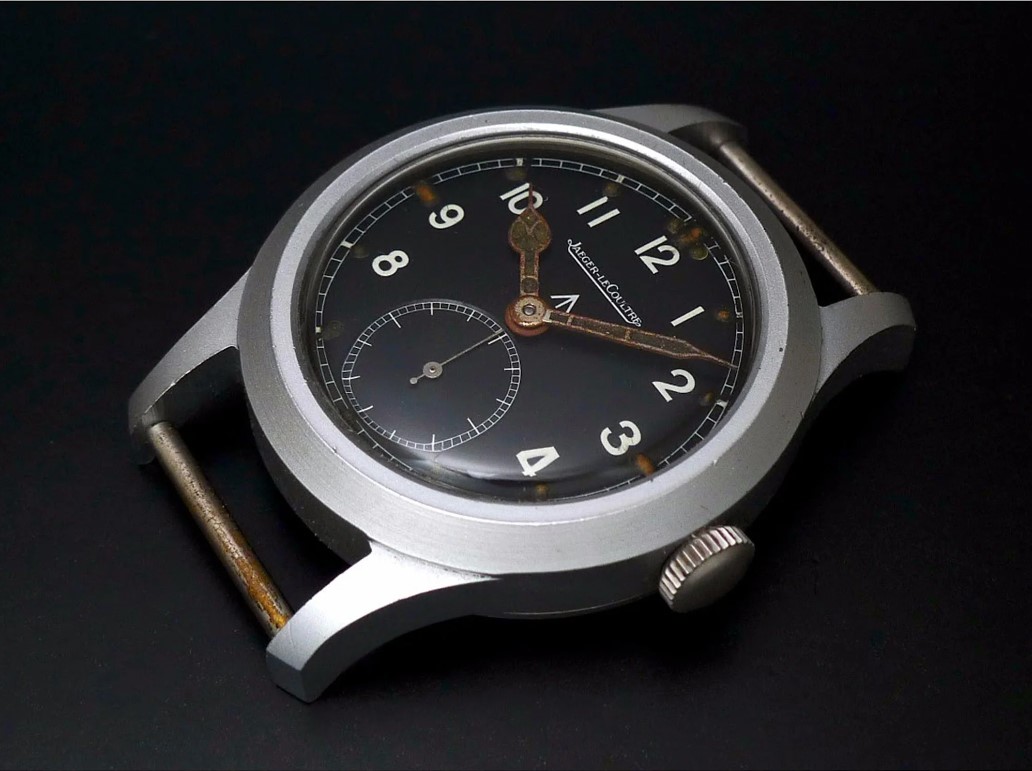
Jaeger-LeCoultre, established in 1833 in the heart of the Vallée de Joux in the Swiss Jura, has been called “The Watchmaker of Watchmakers,” and the maison has worked hard to earn the reputation, producing more than 1,242 in-house calibers over its long history — and for much of that history supplying some of them to other major heritage brands like Patek Philippe and Vacheron Constantin. Jaeger-LeCoultre’s most iconic watch is undeniably the Reverso, made since 1931 and recognizable by its swiveling, reversible case, which was initially conceived as a sports watch for polo players to wear during matches. Another signature innovation from Jaeger-LeCoultre came in 1968: the Polaris Memovox, a diver’s watch equipped with a mechanical alarm, which exerts its aesthetic and technical influence on an entire collection of Polaris sport-luxury models today. Jaeger-LeCoultre’s watch for the MoD during World War II weighed in at a relatively modest 35mm (17mm lug width), with a steel caseback and chrome bezel, and cathedral hands rather than the sword hands on most of its siblings. Like virtually all Jaeger-LeCoultre watches then and now, it contained an in-house movement, the manually wound Caliber 479.
Lemania
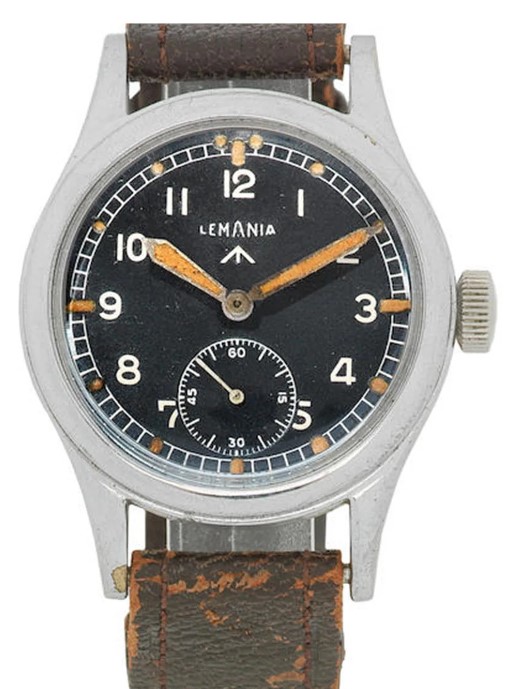
Before it became renowned for producing high-end movements for Omega, and eventually Breguet, Lemania, founded in 1884, made its own watches. After merging with Omega and Tissot to form the SSIH Group in 1932, Lemania (which took its name from Switzerland’s Lac Leman, or Lake Geneva) focused most of its efforts on developing complicated calibers for its partners, including the one that went to the Moon in the Omega Speedmaster. When called upon, however, Lemania built a military wristwatch to the WWW specs for the British Army, of which only about 8,000 were ever made. The watch’s steel-and-chrome case measured 36.5mm in diameter and contained the manually wound Caliber 27A.
Longines
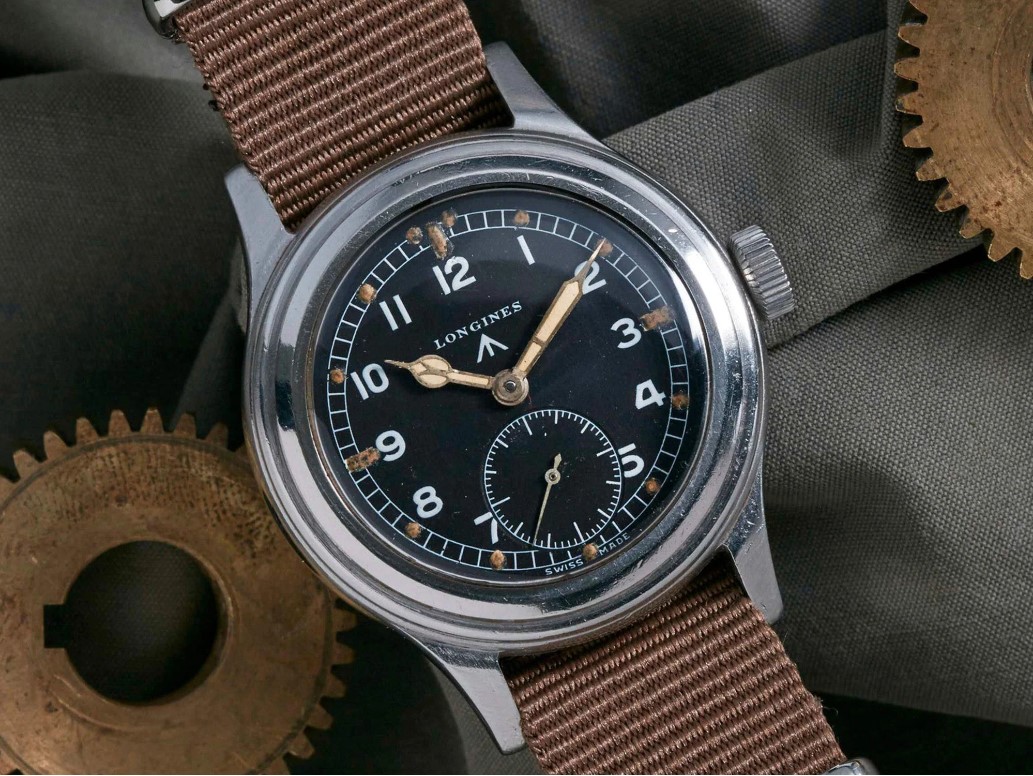
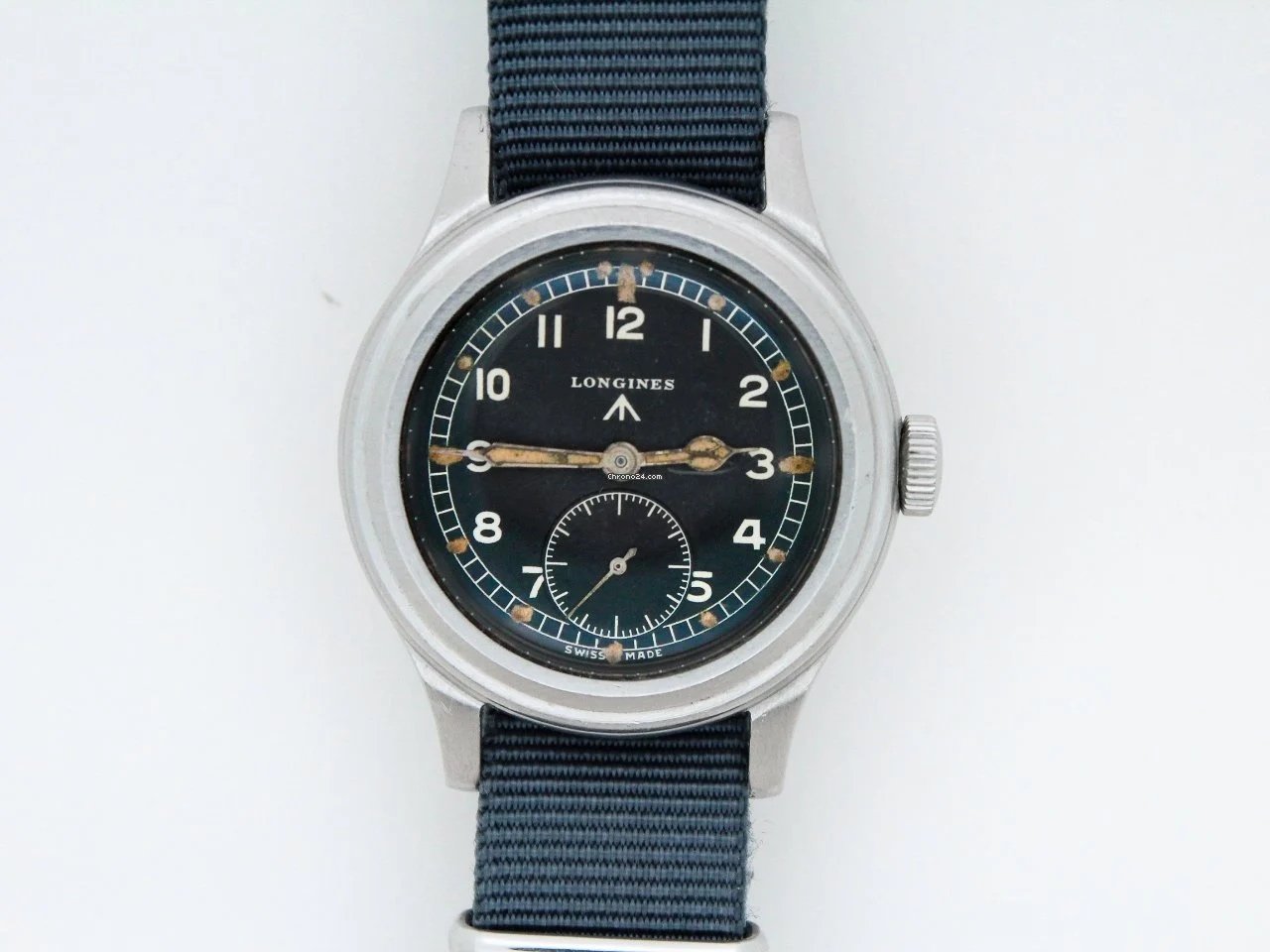
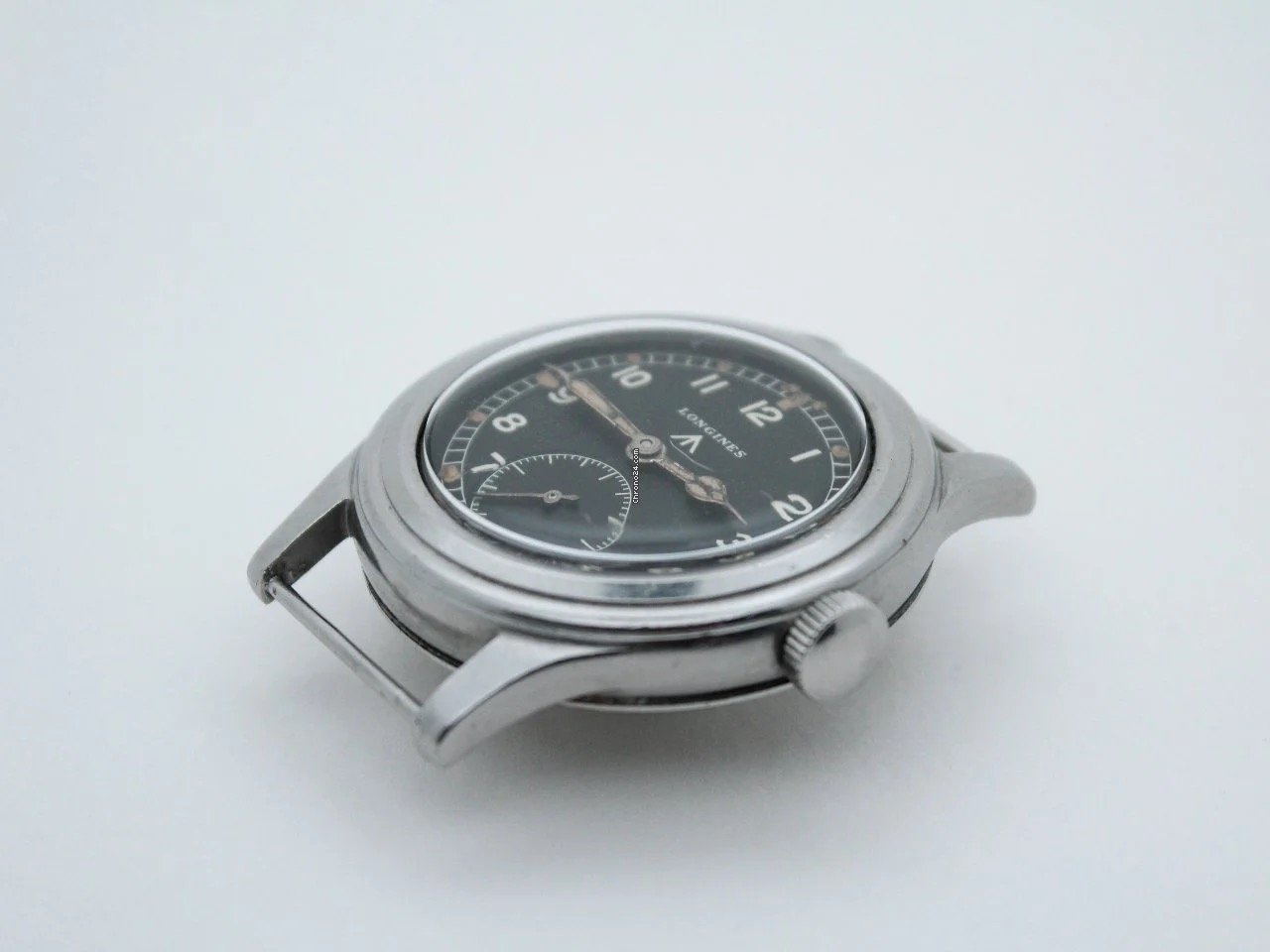
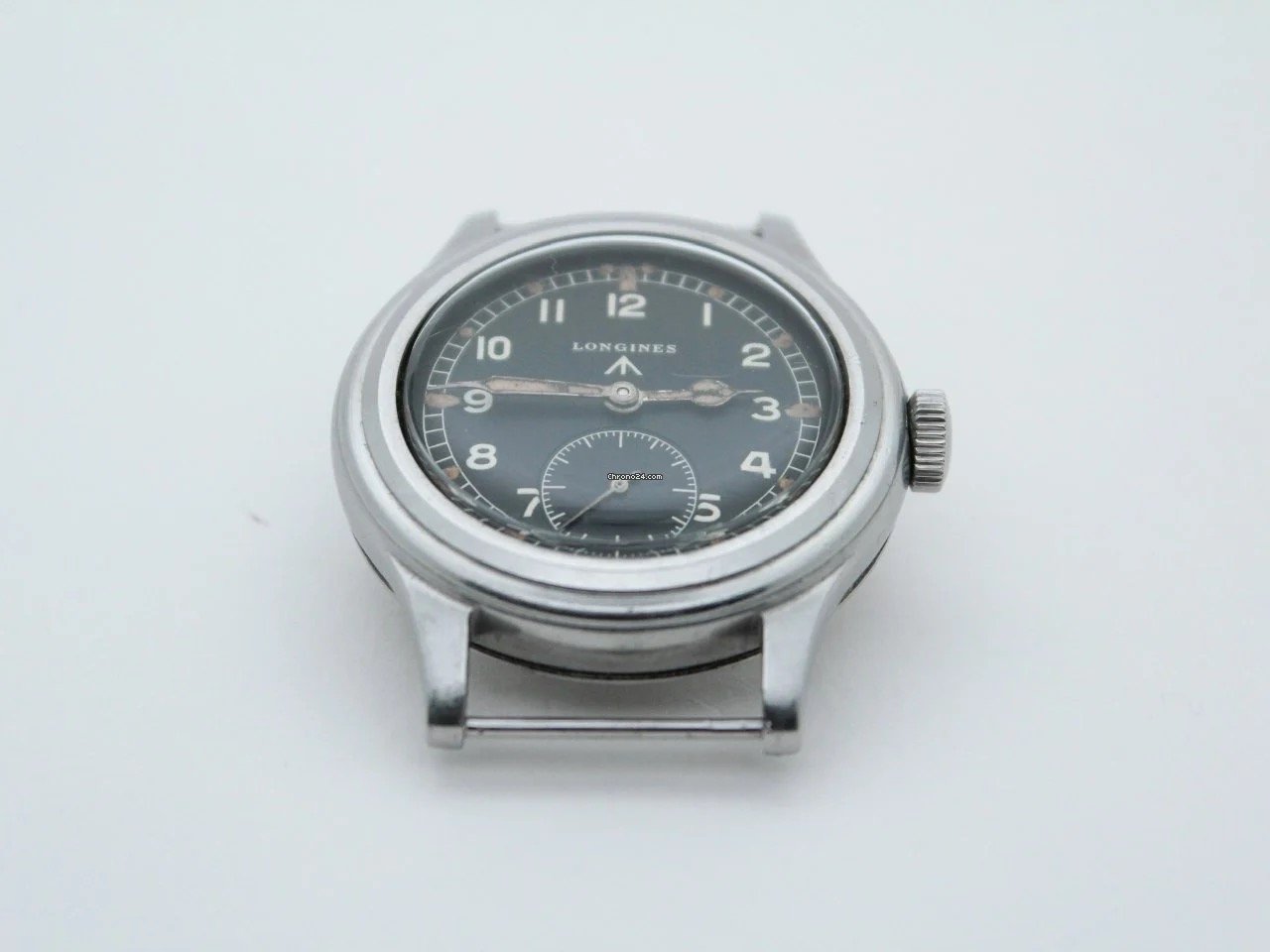
Headquartered in Saint-Imier, Switzerland since its founding in 1832, Longines takes its name from “les longines,” the “long meadows” that surround that picturesque Swiss village. The brand has been a pioneer in sports timing and a one-time Olympic Games timekeeper. The company also looks back on an enviable history of involvement in early aviation, designing the legendary Hour Angle watch with Charles Lindbergh in 1931 and supplying watches to pilots like Howard Hughes, Amy Johnson, and Amelia Earhart. Longines was also one of the first Swiss brands to embrace quartz technology in the 1950s, and remains in that game with its line of Conquest VHP (Very High Precision) quartz-powered models. Longines’s contribution to the Dirty Dozen, Ref. 23088 in stainless steel, has been nicknamed “The Greenlander” due to a long-held (though ultimately debunked) belief that it was worn on the British North Greenland Expedition in 1952-1954. Its 38mm size and cathedral handset distinguish it from the others and make it a favorite of many.
IWC

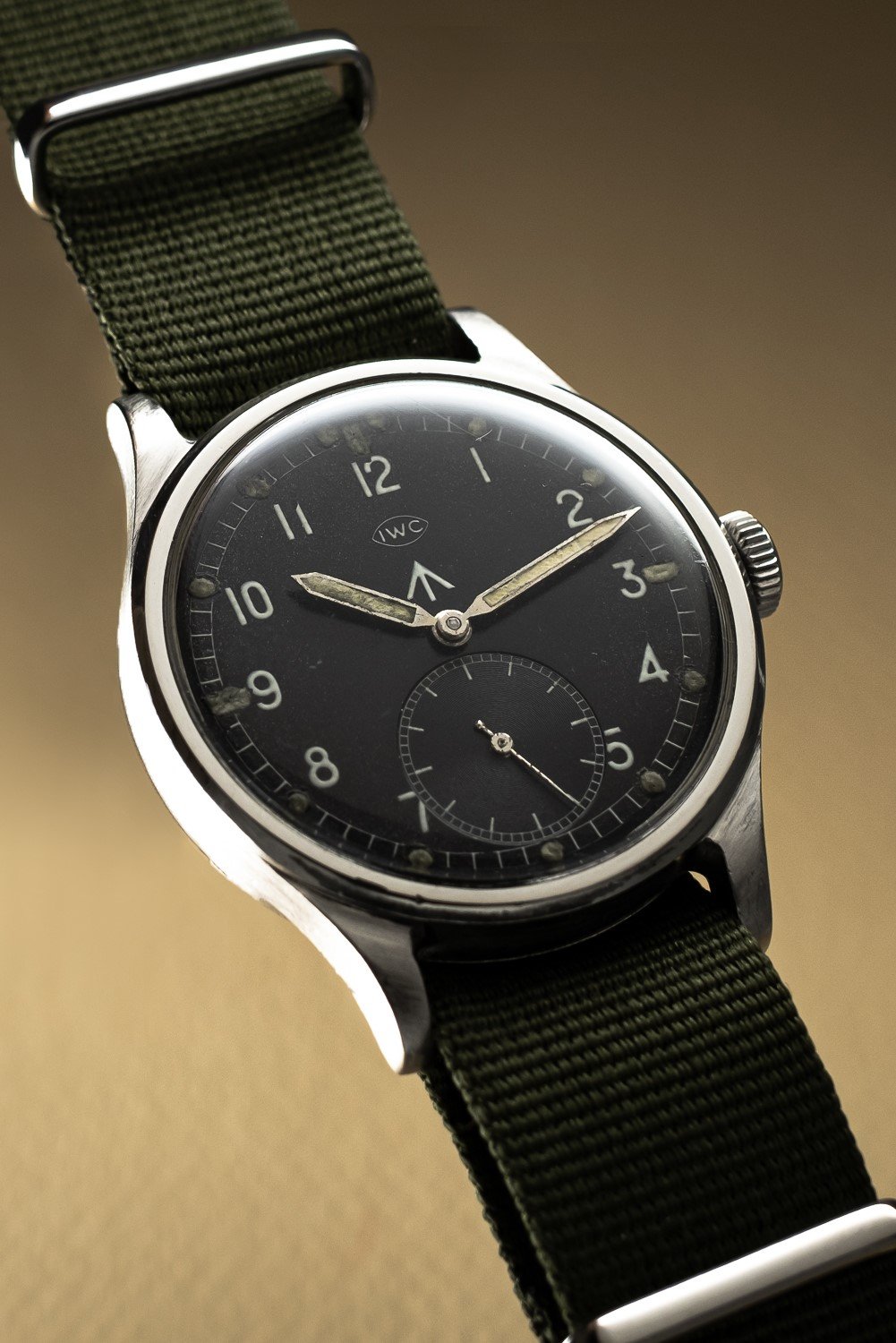
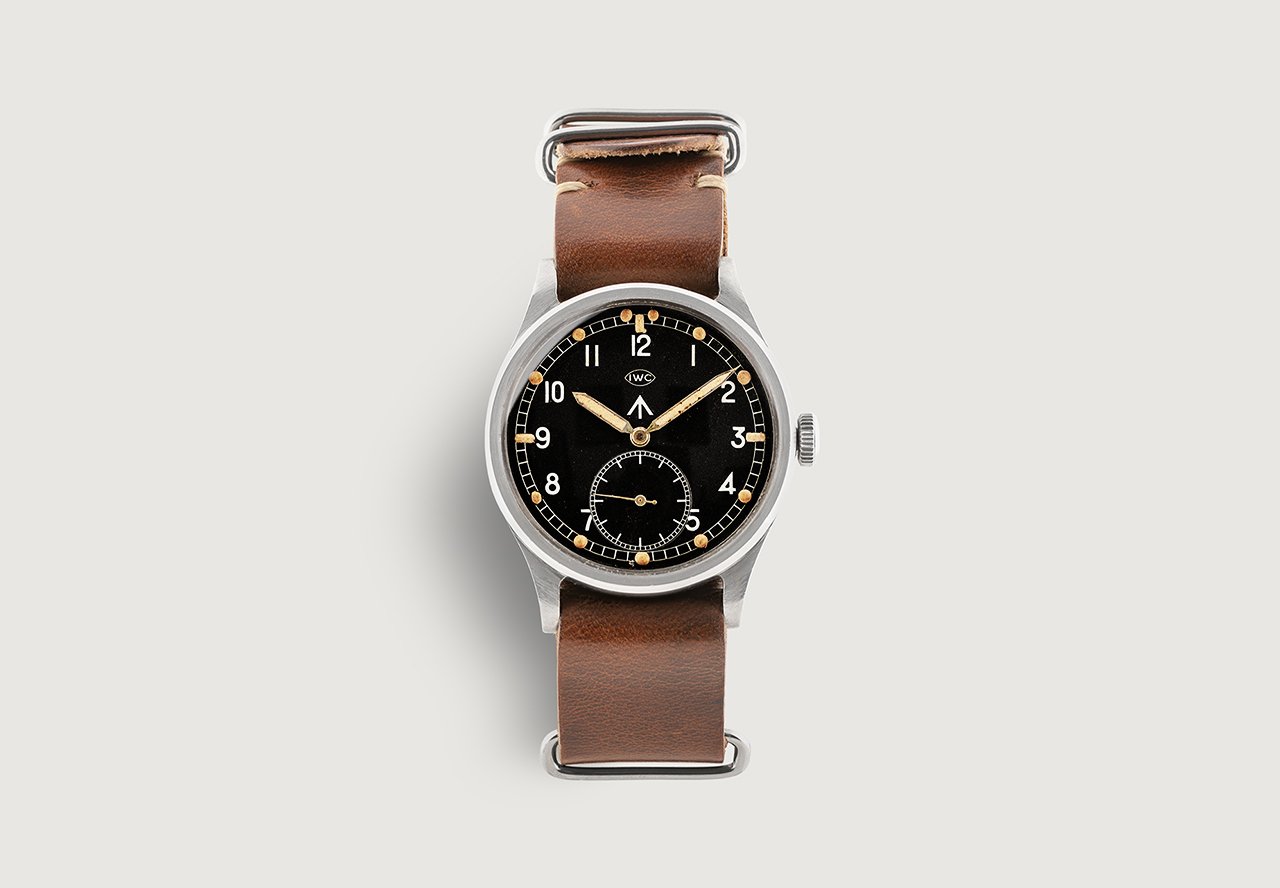
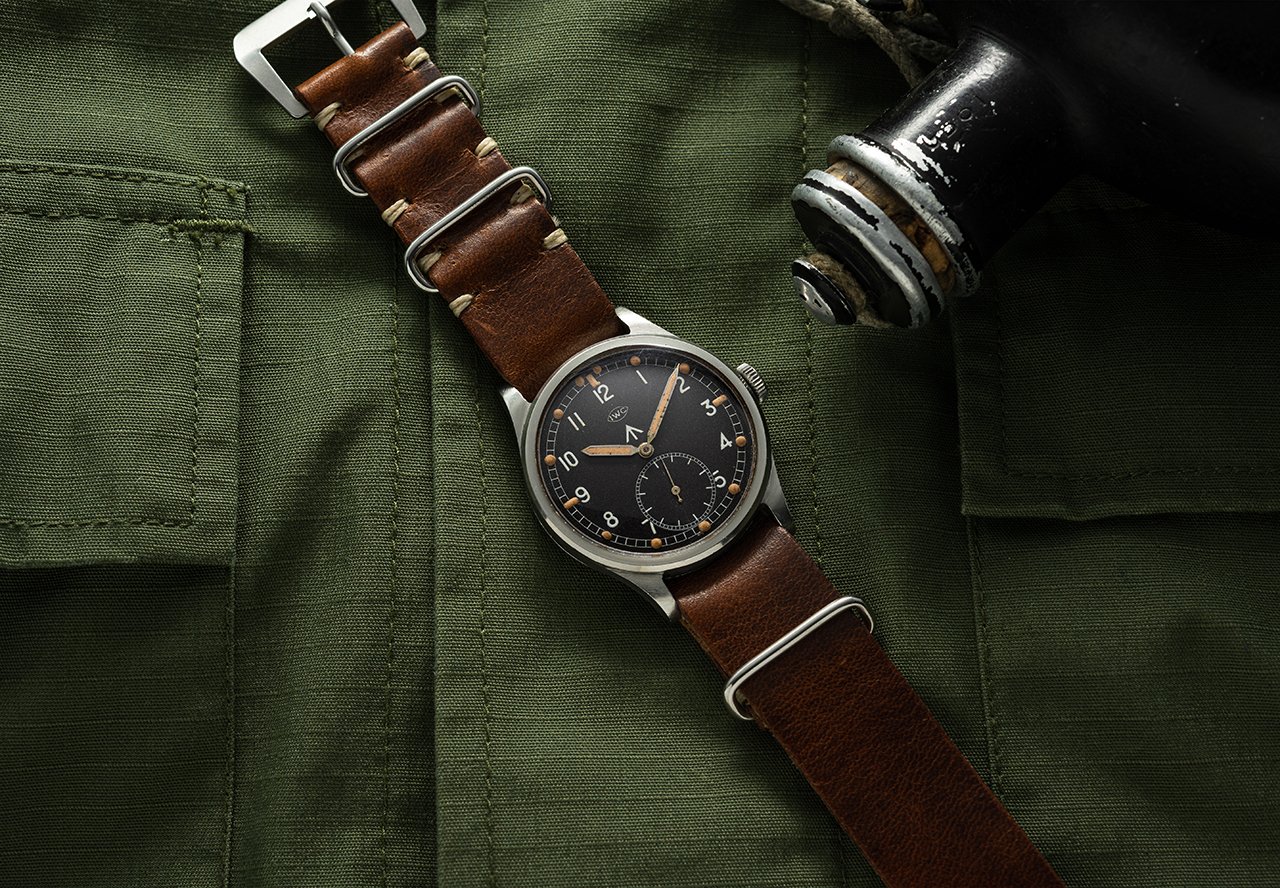
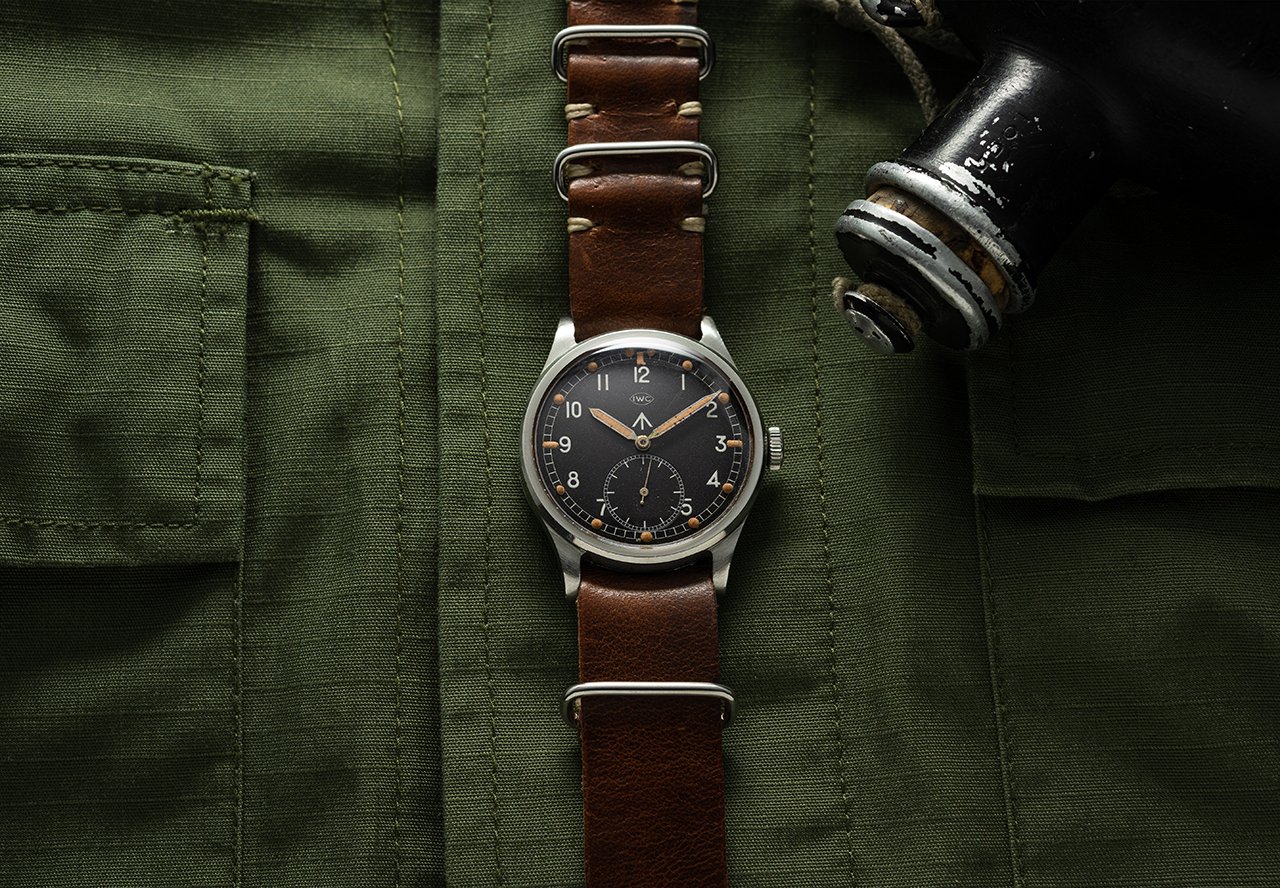
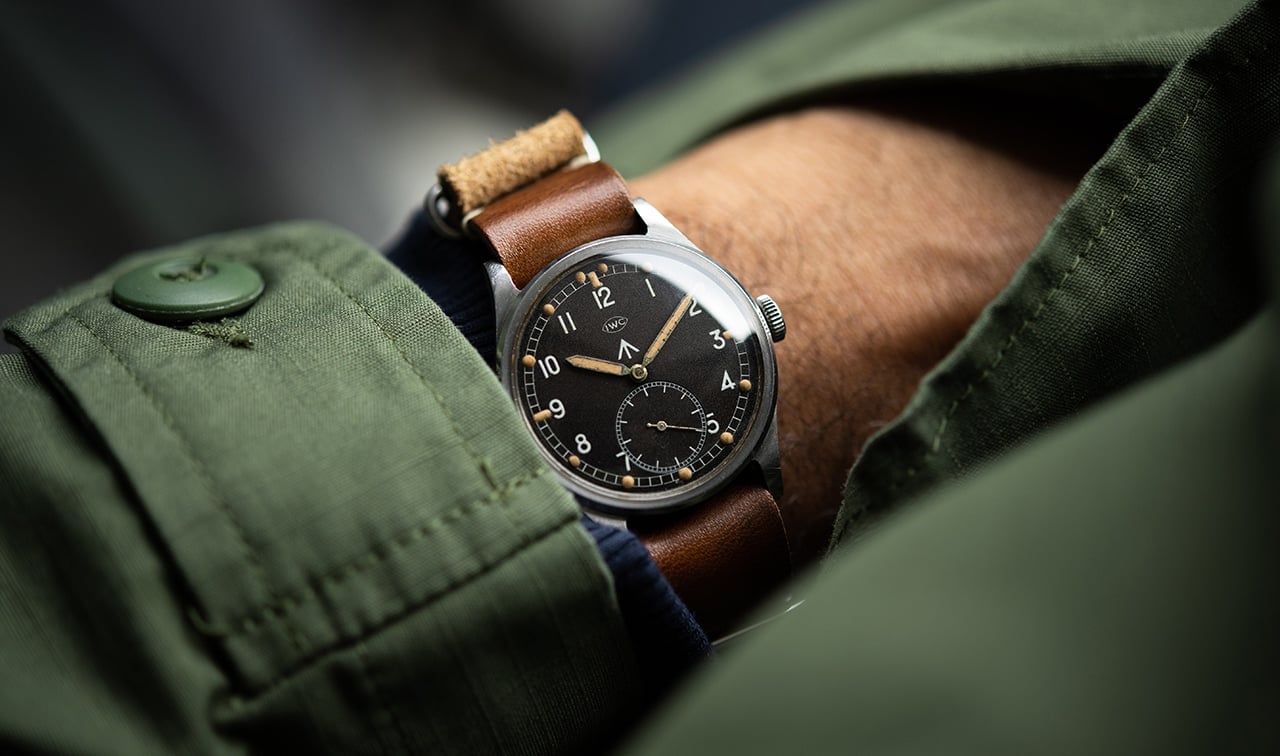
Notably the first and still only Swiss watch firm founded by an American (New England watchmaker Florentine Ariosto Jones), IWC is also one of the few watchmaking houses headquartered in Schaffhausen, in Switzerland’s northeastern, German-speaking region. Originally a maker of ornate pocket watches, IWC is most famous today for its family of aviation watches, like the Big Pilot’s watch, first worn by Luftwaffe pilots during World War II; the Spitfire series, based on the Mark 11 worn by British RAF pilots in the 1950s (pictured above, via Analog Shift); and the Top Gun collection, made in cooperation with the U.S. Navy Fighter Weapons School. The Spitfire pilot’s watch draws its direct lineage from IWC’s Mark X, the field watch that it produced in 1944-45 as part of the Dirty Dozen. The 35mm steel case contained the Caliber 83, protecting it behind a snap-on caseback, the only one of this type used for a Dirty Dozen watch. The watch is one of the most collectible of the twelve, with a fairly small production run around 5,000 pieces.
Omega

Few Swiss luxury watch brands have had more historical impact on our popular culture than Omega, founded by Louis Brandt in 1848. One of the watch industry’s most trend-setting leaders, Omega created some of the first minute repeaters and tourbillons for the wrist, and was the first to use the revolutionary co-axial escapement in its calibers. By far its best known watch model is the Speedmaster Professional, aka the “Moonwatch,” which in 1969 became the first watch worn on the moon and has been a mainstay of NASA space missions ever since. Omega has been a timing partner of the Olympics since 1932 and regularly releases collectible special editions in concert with the Games. Since 1995, Omega has been the official watch of James Bond, with both Pierce Brosnan and Daniel Craig sporting the naval-inspired Seamaster model in various iterations on the big screen. Omega’s Dirty Dozen model measured 35mm in steel, and contained the manually wound Omega Caliber 30T2. It remains one of the more collectible models, not because of its rarity — it’s estimated about 25,000 were produced — but because of the always powerful Omega brand name.
Record

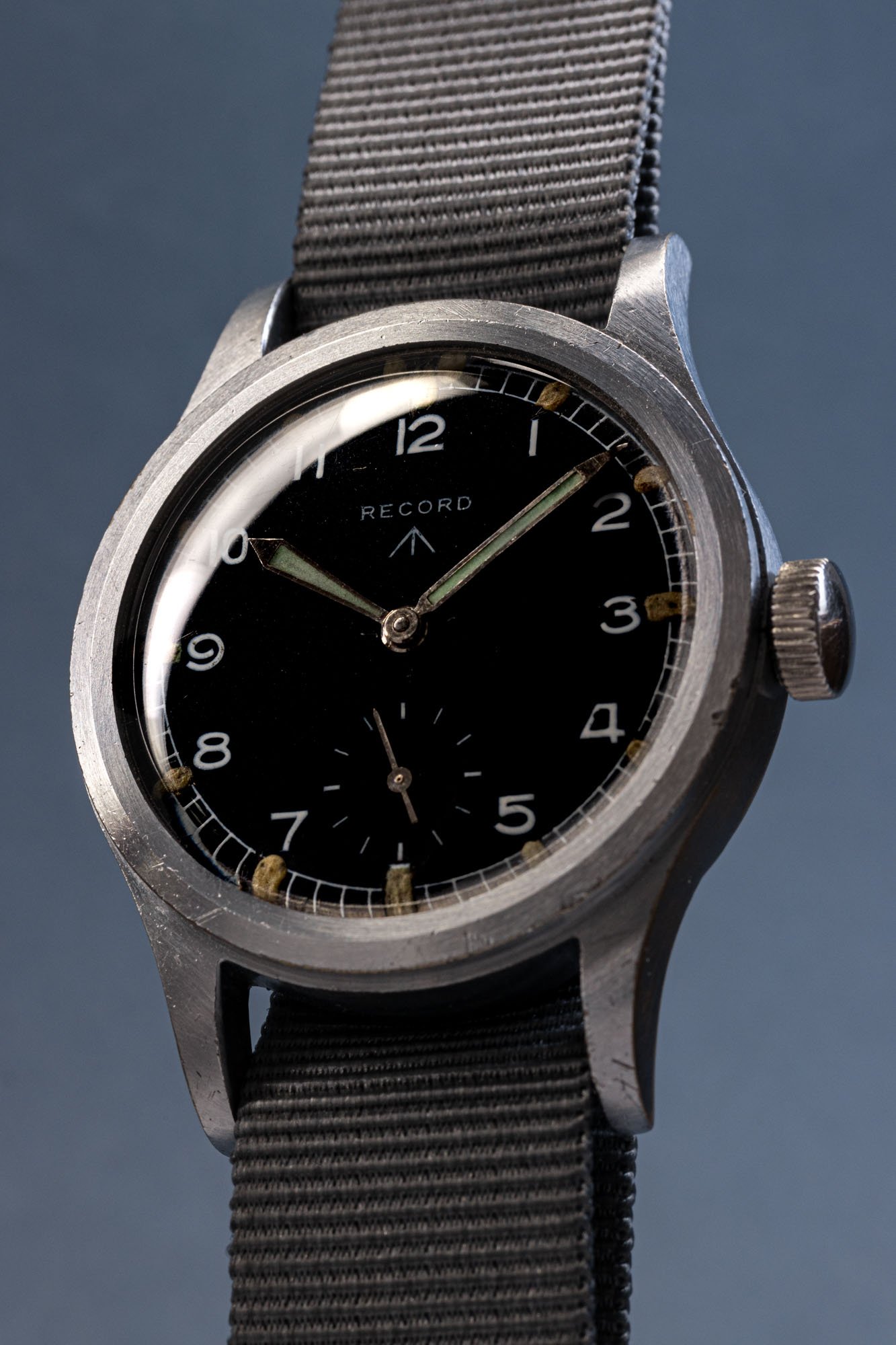
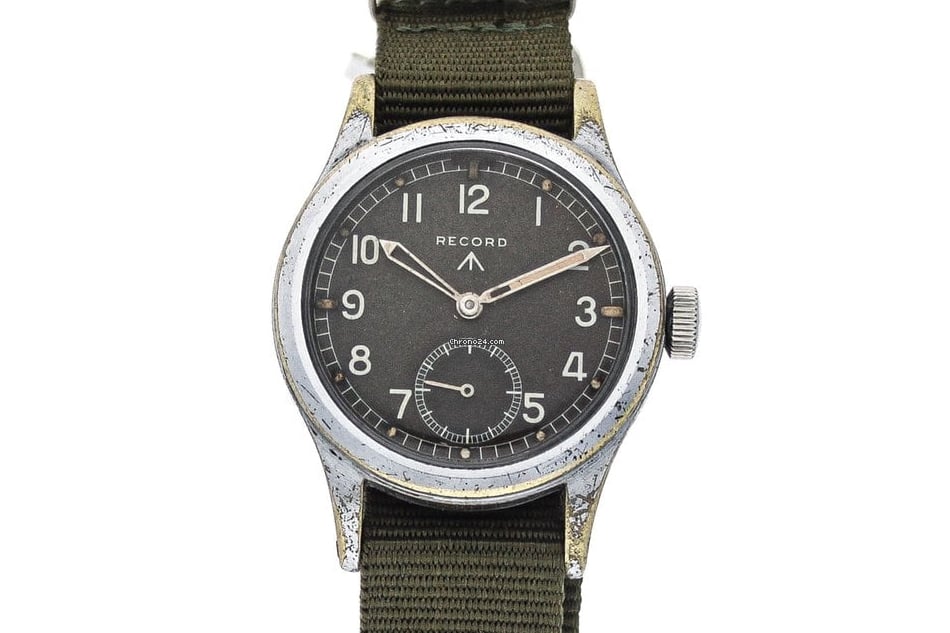
Wait, isn’t the Record a watch model produced by Longines? Well, yes and no. The Record Watch Co. was founded in the Swiss Jura Mountains in 1903 and was known as the maker of the popular, triangular “Sector” pocket watch before delving more deeply into wristwatches in the early 20th Century, including high-end chronographs in the 1930s. After World War II, Record continued making innovative complications like an in-house calendar with moon-phase, the Datofix, in 1949. Longines absorbed the Record brand in the 1960s and discontinued its operations in 1991; recently, Longines has resurrected the Record style in a series of vintage-flavored models under the Longines brand umbrella. The Dirty Dozen watch produced by Record measured 36.5mm in chrome-plated steel and held the Caliber 022K behind its screw-on caseback.
Timor
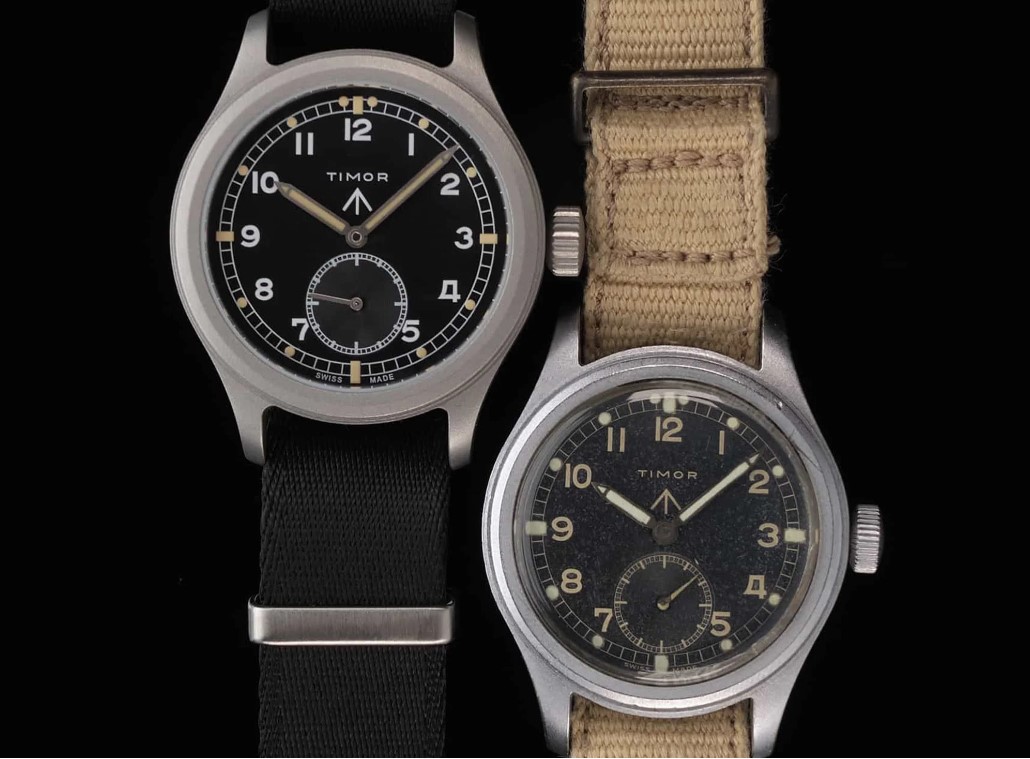
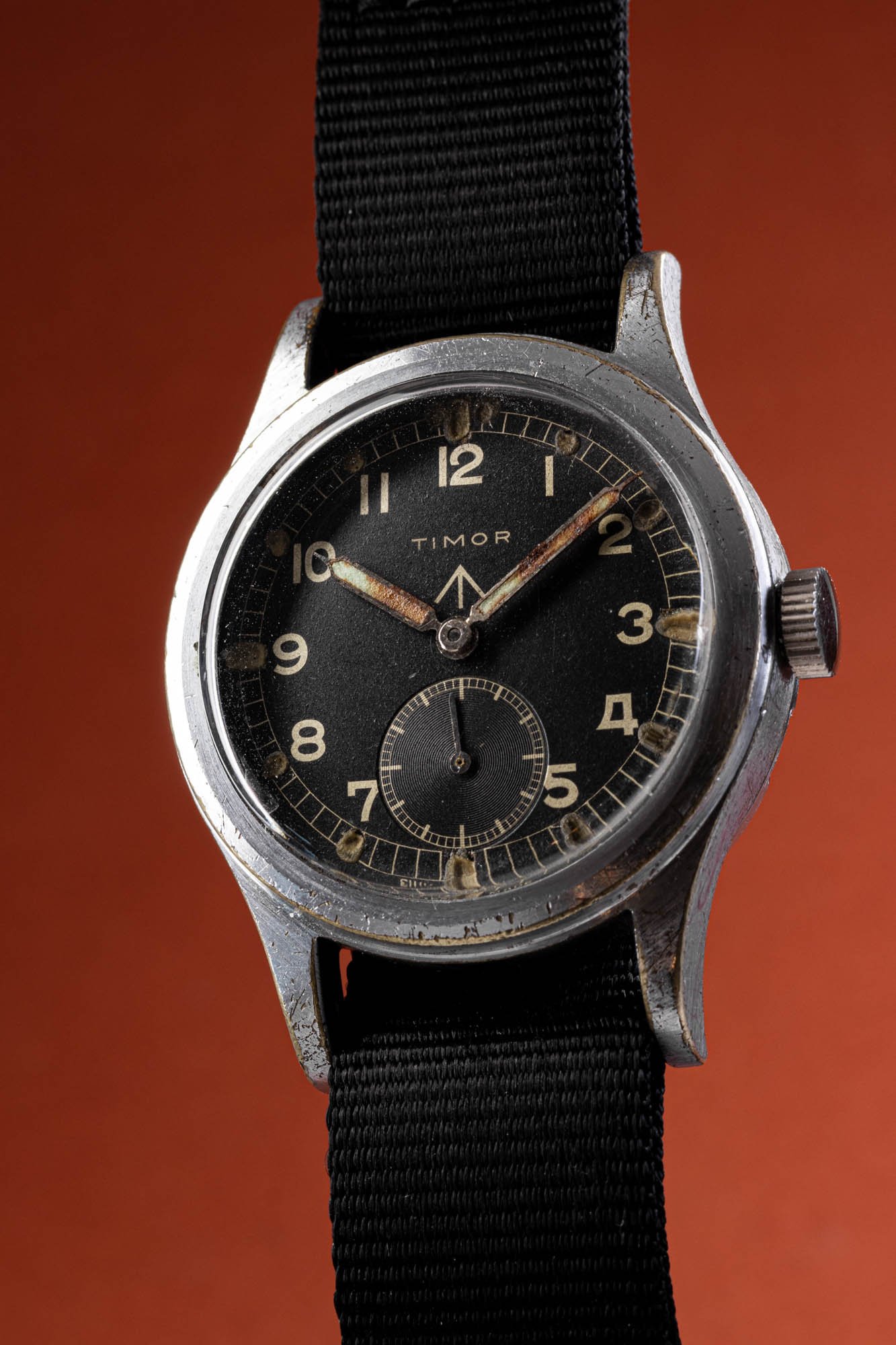
Timor started making watches in 1923 in La Chaux-de-Fonds and was noted for making one of the first watches for partially sighted people in 1931; the timepiece featured a hinged crystal over the dial and Braille numerals. The brand was popular in Britain and made one of the first wristwatches for the British Army, even before the W.W.W. specs that gave rise to the Dirty Dozen. Now headquartered in the U.K., Timor has returned to its roots after a dormant period during the Quartz Crisis to produce vintage-influenced pieces like the Timor Heritage Field, which evokes the look of its “W.W.W.” model from the 1940s, of which 13,000 are believed to have been produced. The original watch’s chrome-plated 36.5mm steel case contained the mechanical Caliber 6060 and its black dial hosted luminous pencil-shaped hands. The modern re-creation (above, next to the vintage Dirty Dozen model) has identical case dimensions and a hand-wound Sellita SW216-1 movement.
Vertex
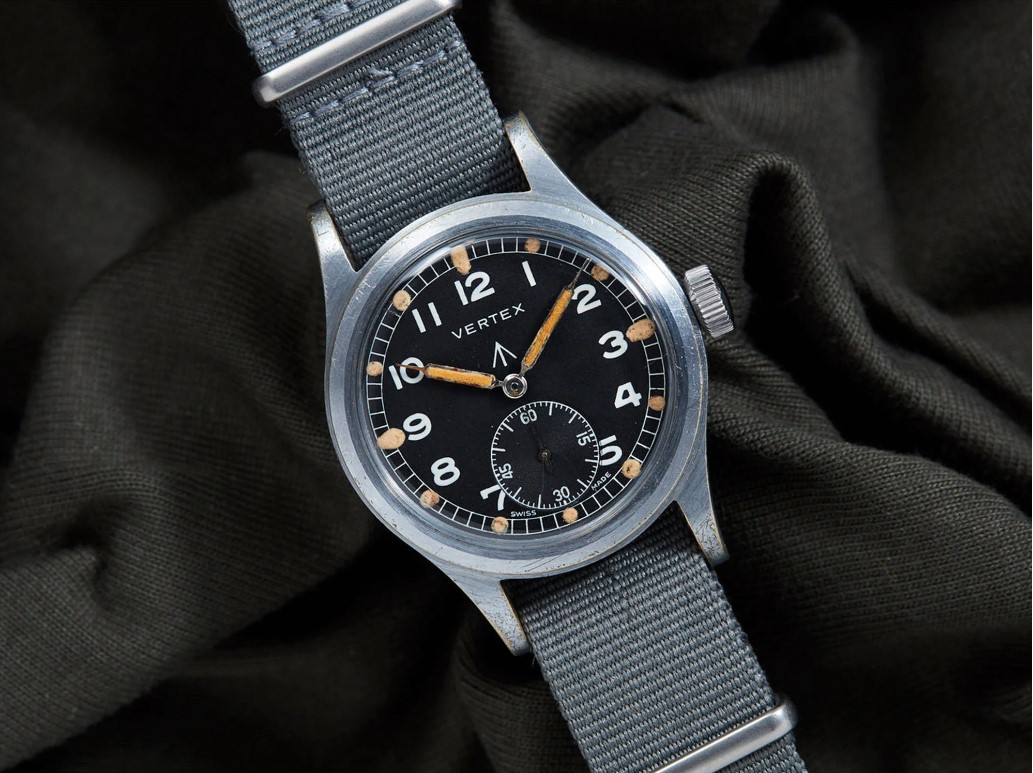
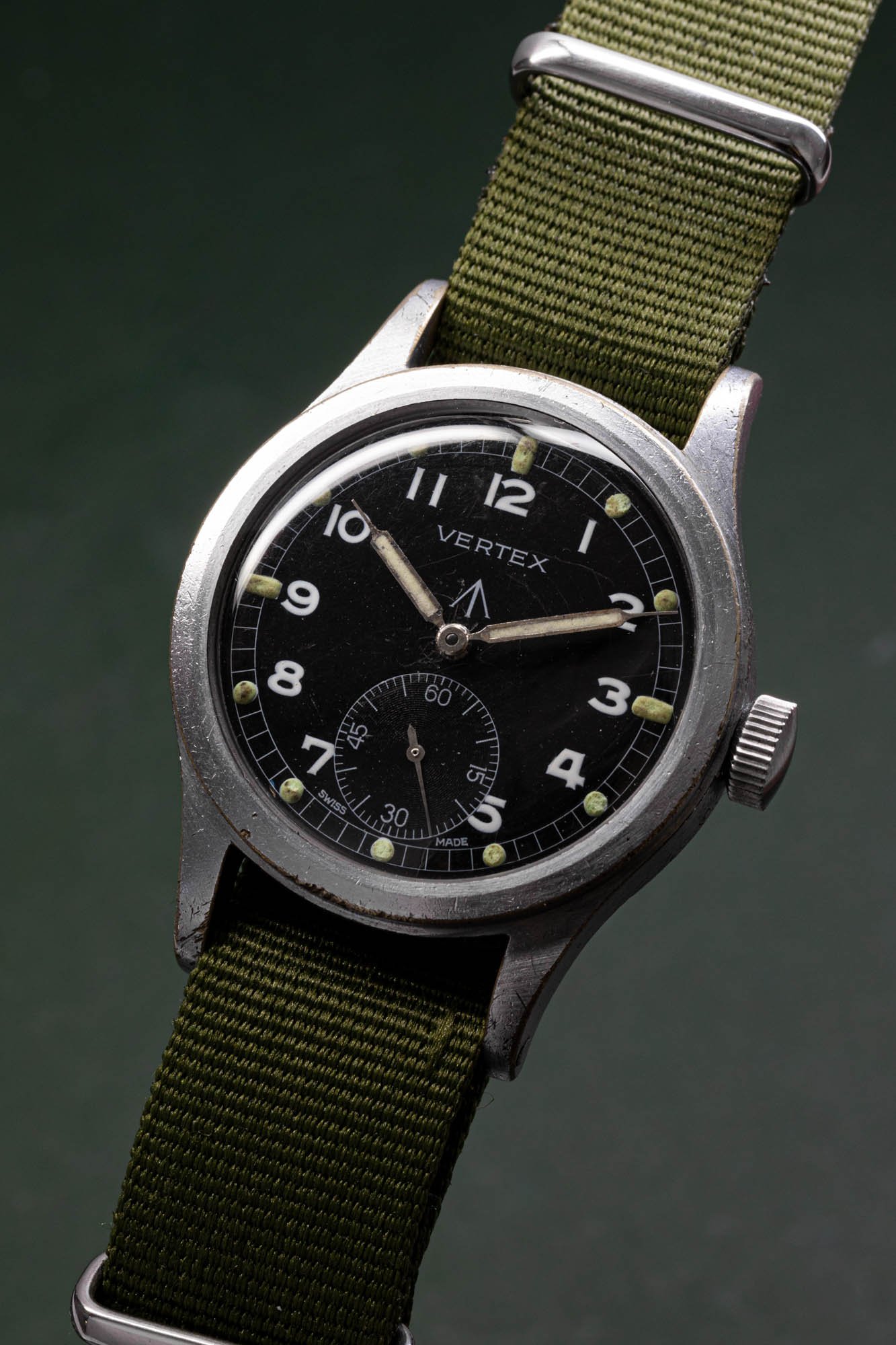
Specializing in making watches in Britain with Swiss-made movements, Vertex traces its origin to 1912, when founder Claude Lyons borrowed 1,000 pounds from his father and started making watches for British troops in World War I. By the 1920s, the company had a factory in La Chaux-de-Fonds and had expanded into other types of timepieces, like ladies’ jewelry watches. Henry Lazarus, Claude’s son-in-law, took over the company in 1938 and shortly parlayed his stint as an Army Captain into opportunities to provide watches to the troops. For the Dirty Dozen, Vertex contributed the chrome-topped, 35mm, Caliber 59-equipped W.W.W. Nav watch, which according to the modern brand was sent to troops preparing for the D-Day invasion in 1944. Vertex shut down in 1972 and reopened in 2015, run by Claude Lyons’ great-grandson. Like Timor, Vertex has revisited its Finest Hour of watchmaking during World War II to inspire its modern collection, including the heavily Dirty Dozen-inspired M100 series.
Disclaimer: some parts of the above are copy-pasted from internet sources, I’m not claiming intellectual property of any of that (I’m a plagiarist, yes), but the purpose of the thread is to offer some knowledge on these beautiful field watches that set the standard for a design language that is still popular today. I love these watches.
It's a Sunday but not an usual one. Germany has invaded Poland two days prior and many Englishmen and -women are listening to the BBC to know what will happen next. Their anxious wait is rewarded – although the term is utterly paradoxical for the outcome – at 11:15 am. Prime Minister Neville Chamberlain, after a brief introduction, announces: "This country is at war with Germany". Fade to black.
War. In 1939, the British Government found itself suddenly in need to equip an Army. This also meant that soldiers, pilots and sailors needed watches. Unfortunately, the great British horological tradition which had already supplied the British Military in the past with top tier products, especially marine chronometers for the Royal Navy (Harrison, Arnold) or Smith’s trench watches in WWI, had largely lost its momentum to the more powerful Swiss production capabilities. Besides, the english manufacturing capability was more needed in the weapons industry.
Switzerland would export very large quantities of watches and pocket watches equally to Allied forces and the Germans. The British military was initially supplied with so-called A.T.P. watches ordered in 1939. A.T.P. stands for ‘Army Trade Pattern,’ the set of design rules created for watches destined for Her Majesty’s armed forces. The ‘pattern’ was the following: a watch case from 30 to about 34mm. A white or silver dial with black numerals for legibility. A small second or ‘running seconds’ on the dial to aid in more precise timing coordination. Fixed bars at the lugs so the strap always stays connected to the wearer. A reliable and accurate movement of 15 jewels or more. Finally, the hands and dial markers needed to be painted with some sort of luminous material to aid in night work. Seventeen Swiss watch companies answered the call by the British Ministry of Defense to build these timepieces. They were: Buren, Cortebert, Cyma, Ebel, Enicar, Font, Grana, Lemania, Leonidas, Moeris, Reconvilier, Record, Revue, Rotary, Timor, and Unitas.



However, by 1944 the British Ministry of Defense thought these were not suitable to the needs of British soldiers, and decided to place an order for custom-built wristwatches. These needed to be accurate, reliable and durable, which in watchmaking terms meant they had to be regulated to chronometer standards, and also be waterproof and shockproof.
The watches also had to have a black dial, Arabic numerals, luminous hour and minute hands, luminous hour markers, a railroad minute track, a shatterproof crystal, and a stainless-steel case. Powering them would be 15-jewel movements, measuring between 11.75 and 13 lignes (cfr.: https://en.wikipedia.org/wiki/Ligne...es to,equivalent of 0.0888 international inch.).
Twelve companies would fulfill this brief: Buren, Cyma, Eterna, Grana, Jaeger-LeCoultre, Lemania, Longines, IWC, Omega, Record, Timor, and Vertex. A thirteenth brand, Enicar, was also addressed by the MoD but never supplied the watches.

Each manufacturer delivered according to its production capabilities, from the 25.000 of Omega to the 1.000 (maybe up to 5.000) of the Grana. The Dirty Dozen started production in February and March 1945 and supplied their watches later that year.

The Dirty Dozen are easily identifiable by the engraving on the back. The three Ws, which stand for for Watch, Wrist, Waterproof, and indicate the type of good in order to distinguish them from weaponry. Other defining features include Broad Arrow heads; the use of the Broad Arrow for government goods goes all the way back to Sir Philip Sidney, Joint Master of the Ordnance in 1585, whose family used the Broad Arrow in its coat of arms – traditionally used to denote the property of the UK government - , on the dial, inner case, and at the back, and two more lines of engravings at the back: a military serial number – a capital letter followed by up to five digits – above a second, standard civil serial number - some watches have the civil one on the inner case.





The specification from the MoD left room for interpretation in designing the watches. No two versions look alike. Sizes varied quite a bit. The Grana, IWC, JLC, Omega, and Vertex versions are the smallest, measuring 35mm. The Longines is the largest at 38mm.

Another distinguishing feature is the handset. We see variations from the narrow syringe-style hands of the Vertex to the large cathedral handsets of the Longines and JLC. The dials are nowhere near the same, either. The numerals are different — just let your eye flow across all the 4s, for instance. The sub-dials for the running seconds are different sizes, and some feature numerals where others don’t. All feature the government-specified arrowhead, but even that is executed in different shapes.
The cases vary quite a bit as well. Some are stainless steel, whereas others are chrome-plated. To find a good, unrestored example of the latter nowadays is nearly impossible. The case shape itself is also different across the manufacturers. We see stepped bezels, domed bezels, flat bezels, and sloped bezels. Lastly, all were fitted with a screw-in case back except for the IWC, the back of which was snap-on.
Since the watches were only delivered in the second half of 1945, many did not see that much action. A total of around 150,000 watches were produced. They primarily landed with specialist units, such as radio operators. While many did not, large numbers also did end up on the battlefield.

Due to the extreme conditions they were subjected to, many of them were repaired and restored at some point during their lifetime. And that meant being sent back to the Corps of Royal Electrical & Mechanical Engineers (R.E.M.E), which dealt with all mechanical equipment in need of maintenance or repair, including watches worn by military personnel.

Of course, the Corps had little interest in preserving the originality of the watches that came back. Their primary concern was to get them back in the field as quickly as possible, and they found it much more practical and time efficient to restore watches using MoD replacement parts of lower quality and in some cases, with parts from other models. Mistakes were made, especially when changing case backs. And then there's what happened after the war. In the 1960s, dials containing radium and promethium were replaced by non-radioactive dials.
A small number of W.W.W.s was salvaged by the MoD after the war. Interestingly, these were then sold to other armed forces. Some went to the Dutch and Indonesian armies, others to the Pakistani military. Some of these watches saw action in Indonesia during the decolonization from the Netherlands. Most W.W.W.s feature two serial numbers on the case back, one military and one civilian. The resold versions received a third and sometimes a fourth serial number from their new owners. This makes Dirty Dozen watches with three/four serials extra collectible today besides the elusive Grana.

The moniker “Dirty Dozen” derives from the namesake movie from 1967 starring Lee Marvin, Charles Bronson, John Cassavetes, Telly Savalas, Donald Sutherland, Ernest Borgnine, George Kennedy and others. The movie, although heavily romanticizing World War II, is a must-see for the lovers of the genre. The younger audience will know Quentin Tarantino’s Inglorious Basterds, which directly references the old movie in more than one scene.

Analogous romanticism is today reserved to the Dirty Dozen watches. These are highly collectible and in some cases surprisingly affordable in comparison to what the watch world is used to today. But again, some of them are also quite rare. It is believed that there are no more than 20 full collections featuring all 12 watches. A full collection was sold in August 2020 for 27.000 GBP (>34,000 incl. fees).

Buren

Buren Watch Company was founded in the Swiss canton of Bern in 1898, owned and operated by London-based H. Williamson Ltd. primarily as a maker of pocket watches and table clocks. In 1966, Swiss-based Buren became part of Hamilton Watch Co., which at the time was still based in the U.S.A., and quickly became the manufacturer of the majority of Hamilton watches, effectively accelerating the end of domestic production for the historical American brand. The merged Hamilton-Buren firm was one of a handful of pioneering Swiss watch manufacturers, along with Heuer and Breitling, that developed the groundbreaking Chrono-Matic caliber in 1969, one of the world’s first self-winding chronograph movements. In 1971 it became part of the SSIH group and eventually the Swatch Group. Hamburg-based Schweizer Uhren Edicionen acquired the Buren brand and operates it today. Buren’s chrome-finished watch measured 36.5mm, with sword hands, and carried the Caliber 462 “Grand Prix” movement, which the company made in-house.
Cyma


Brothers Joseph and Theodore Schwob founded Cyma in 1862, taking the name from the Latin word for “sprout,” which evolved into the French word for “summit” (cime). It made luxury watches touted for their resistance to electricity, magnetism, and temperature extremes at its factory in La Chaux-de-Fonds and became known for its expertise in high complications like minute repeaters. Today, still based in Switzerland, the company is owned by Hong Kong-based Stelux International Ltd. Despite its relatively healthy production run compared to others (20,000 pieces, according to estimates), Cyma’s Dirty Dozen Watch is a favorite of many due to the sizing of its case (a somewhat contemporary 37mm) and its construction in stainless steel, a quality material that was rare at the time due to wartime shortages. Inside is the mechanical Caliber 234, with 15 jewels.
Eterna

Founded in 1856, Grenchen-based Eterna can lay claim to many watchmaking milestones but is renowned mainly for providing the foundation of today’s ETA movement-manufacturing giant: the co-founding Schild family were the technical innovators who set up the subsidiary ETA SA in 1932, which is today part of the Swatch Group and a major pillar of the Swiss watch industry. Outside of that, Eterna is known for the release of the pioneering Kon-Tiki divers’ watch, inspired by explorer Thor Heyerdahl’s legendary Polynesian raft expedition in 1947; for the development of the Eterna-Matic movement in 1948, the first caliber with a friction-reducing ball-bearing rotor system; and for one of the first wristwatches with a mechanical alarm. Today, the venerable firm is owned and operated out of China by Citychamp Watch and Jewellery Group. Eterna’s Dirty Dozen watch (36mm in stainless steel, with the manually wound in-house Caliber 520) is among the rarest, with only 5,000 or so pieces ever made.
Grana


Grana is a name you won’t find on a watch dial these days, because in the 1940s this Grenchen-based watch manufacturer, founded in 1888 by the Swiss Kurth brothers Adolf and Alfred, became known as Certina. While far from the most famous brand name on this list, Grana has the distinction of making the rarest and thus most coveted timepiece in the Dirty Dozen, the Holy Grail of the Holy Grails. No one’s sure how many were produced, but the number is almost certainly fewer than 5,000 and maybe as few as around 1,000. In April 2022, a Grana watch from the Dirty Dozen sold at auction for 12,000 GBP.
Jaeger-LeCoultre

Jaeger-LeCoultre, established in 1833 in the heart of the Vallée de Joux in the Swiss Jura, has been called “The Watchmaker of Watchmakers,” and the maison has worked hard to earn the reputation, producing more than 1,242 in-house calibers over its long history — and for much of that history supplying some of them to other major heritage brands like Patek Philippe and Vacheron Constantin. Jaeger-LeCoultre’s most iconic watch is undeniably the Reverso, made since 1931 and recognizable by its swiveling, reversible case, which was initially conceived as a sports watch for polo players to wear during matches. Another signature innovation from Jaeger-LeCoultre came in 1968: the Polaris Memovox, a diver’s watch equipped with a mechanical alarm, which exerts its aesthetic and technical influence on an entire collection of Polaris sport-luxury models today. Jaeger-LeCoultre’s watch for the MoD during World War II weighed in at a relatively modest 35mm (17mm lug width), with a steel caseback and chrome bezel, and cathedral hands rather than the sword hands on most of its siblings. Like virtually all Jaeger-LeCoultre watches then and now, it contained an in-house movement, the manually wound Caliber 479.
Lemania

Before it became renowned for producing high-end movements for Omega, and eventually Breguet, Lemania, founded in 1884, made its own watches. After merging with Omega and Tissot to form the SSIH Group in 1932, Lemania (which took its name from Switzerland’s Lac Leman, or Lake Geneva) focused most of its efforts on developing complicated calibers for its partners, including the one that went to the Moon in the Omega Speedmaster. When called upon, however, Lemania built a military wristwatch to the WWW specs for the British Army, of which only about 8,000 were ever made. The watch’s steel-and-chrome case measured 36.5mm in diameter and contained the manually wound Caliber 27A.
Longines




Headquartered in Saint-Imier, Switzerland since its founding in 1832, Longines takes its name from “les longines,” the “long meadows” that surround that picturesque Swiss village. The brand has been a pioneer in sports timing and a one-time Olympic Games timekeeper. The company also looks back on an enviable history of involvement in early aviation, designing the legendary Hour Angle watch with Charles Lindbergh in 1931 and supplying watches to pilots like Howard Hughes, Amy Johnson, and Amelia Earhart. Longines was also one of the first Swiss brands to embrace quartz technology in the 1950s, and remains in that game with its line of Conquest VHP (Very High Precision) quartz-powered models. Longines’s contribution to the Dirty Dozen, Ref. 23088 in stainless steel, has been nicknamed “The Greenlander” due to a long-held (though ultimately debunked) belief that it was worn on the British North Greenland Expedition in 1952-1954. Its 38mm size and cathedral handset distinguish it from the others and make it a favorite of many.
IWC






Notably the first and still only Swiss watch firm founded by an American (New England watchmaker Florentine Ariosto Jones), IWC is also one of the few watchmaking houses headquartered in Schaffhausen, in Switzerland’s northeastern, German-speaking region. Originally a maker of ornate pocket watches, IWC is most famous today for its family of aviation watches, like the Big Pilot’s watch, first worn by Luftwaffe pilots during World War II; the Spitfire series, based on the Mark 11 worn by British RAF pilots in the 1950s (pictured above, via Analog Shift); and the Top Gun collection, made in cooperation with the U.S. Navy Fighter Weapons School. The Spitfire pilot’s watch draws its direct lineage from IWC’s Mark X, the field watch that it produced in 1944-45 as part of the Dirty Dozen. The 35mm steel case contained the Caliber 83, protecting it behind a snap-on caseback, the only one of this type used for a Dirty Dozen watch. The watch is one of the most collectible of the twelve, with a fairly small production run around 5,000 pieces.
Omega

Few Swiss luxury watch brands have had more historical impact on our popular culture than Omega, founded by Louis Brandt in 1848. One of the watch industry’s most trend-setting leaders, Omega created some of the first minute repeaters and tourbillons for the wrist, and was the first to use the revolutionary co-axial escapement in its calibers. By far its best known watch model is the Speedmaster Professional, aka the “Moonwatch,” which in 1969 became the first watch worn on the moon and has been a mainstay of NASA space missions ever since. Omega has been a timing partner of the Olympics since 1932 and regularly releases collectible special editions in concert with the Games. Since 1995, Omega has been the official watch of James Bond, with both Pierce Brosnan and Daniel Craig sporting the naval-inspired Seamaster model in various iterations on the big screen. Omega’s Dirty Dozen model measured 35mm in steel, and contained the manually wound Omega Caliber 30T2. It remains one of the more collectible models, not because of its rarity — it’s estimated about 25,000 were produced — but because of the always powerful Omega brand name.
Record



Wait, isn’t the Record a watch model produced by Longines? Well, yes and no. The Record Watch Co. was founded in the Swiss Jura Mountains in 1903 and was known as the maker of the popular, triangular “Sector” pocket watch before delving more deeply into wristwatches in the early 20th Century, including high-end chronographs in the 1930s. After World War II, Record continued making innovative complications like an in-house calendar with moon-phase, the Datofix, in 1949. Longines absorbed the Record brand in the 1960s and discontinued its operations in 1991; recently, Longines has resurrected the Record style in a series of vintage-flavored models under the Longines brand umbrella. The Dirty Dozen watch produced by Record measured 36.5mm in chrome-plated steel and held the Caliber 022K behind its screw-on caseback.
Timor


Timor started making watches in 1923 in La Chaux-de-Fonds and was noted for making one of the first watches for partially sighted people in 1931; the timepiece featured a hinged crystal over the dial and Braille numerals. The brand was popular in Britain and made one of the first wristwatches for the British Army, even before the W.W.W. specs that gave rise to the Dirty Dozen. Now headquartered in the U.K., Timor has returned to its roots after a dormant period during the Quartz Crisis to produce vintage-influenced pieces like the Timor Heritage Field, which evokes the look of its “W.W.W.” model from the 1940s, of which 13,000 are believed to have been produced. The original watch’s chrome-plated 36.5mm steel case contained the mechanical Caliber 6060 and its black dial hosted luminous pencil-shaped hands. The modern re-creation (above, next to the vintage Dirty Dozen model) has identical case dimensions and a hand-wound Sellita SW216-1 movement.
Vertex


Specializing in making watches in Britain with Swiss-made movements, Vertex traces its origin to 1912, when founder Claude Lyons borrowed 1,000 pounds from his father and started making watches for British troops in World War I. By the 1920s, the company had a factory in La Chaux-de-Fonds and had expanded into other types of timepieces, like ladies’ jewelry watches. Henry Lazarus, Claude’s son-in-law, took over the company in 1938 and shortly parlayed his stint as an Army Captain into opportunities to provide watches to the troops. For the Dirty Dozen, Vertex contributed the chrome-topped, 35mm, Caliber 59-equipped W.W.W. Nav watch, which according to the modern brand was sent to troops preparing for the D-Day invasion in 1944. Vertex shut down in 1972 and reopened in 2015, run by Claude Lyons’ great-grandson. Like Timor, Vertex has revisited its Finest Hour of watchmaking during World War II to inspire its modern collection, including the heavily Dirty Dozen-inspired M100 series.
Disclaimer: some parts of the above are copy-pasted from internet sources, I’m not claiming intellectual property of any of that (I’m a plagiarist, yes), but the purpose of the thread is to offer some knowledge on these beautiful field watches that set the standard for a design language that is still popular today. I love these watches.
